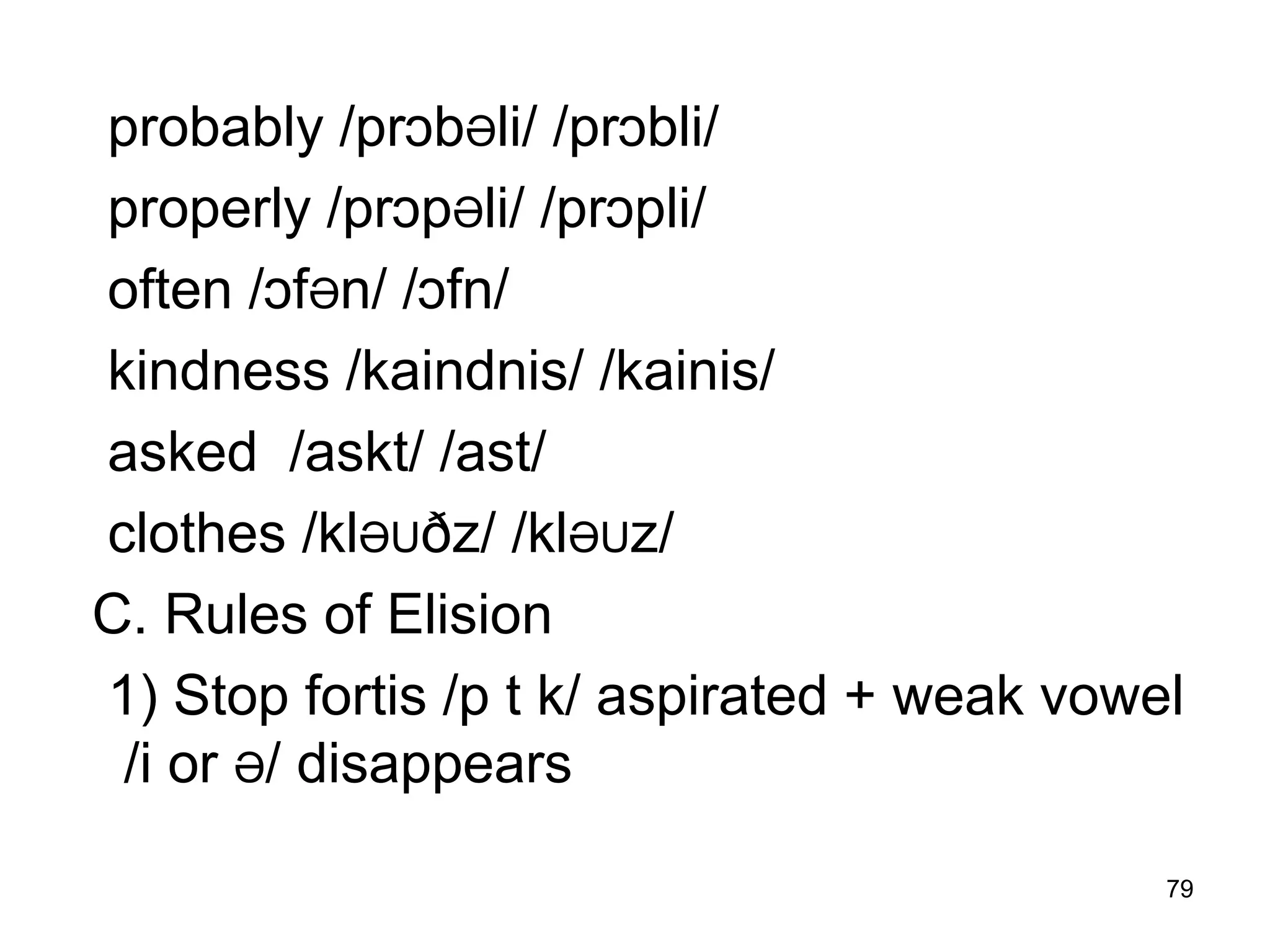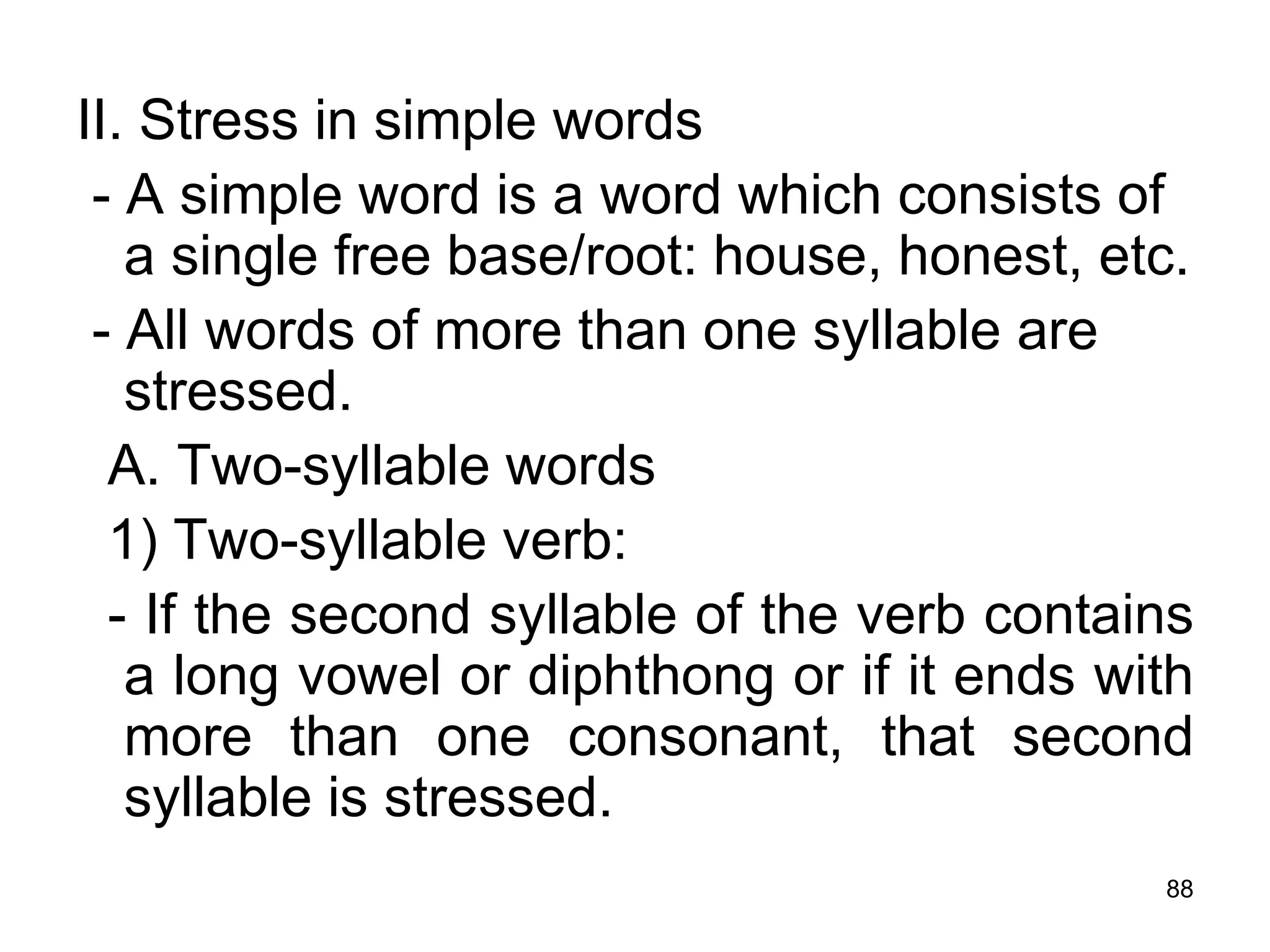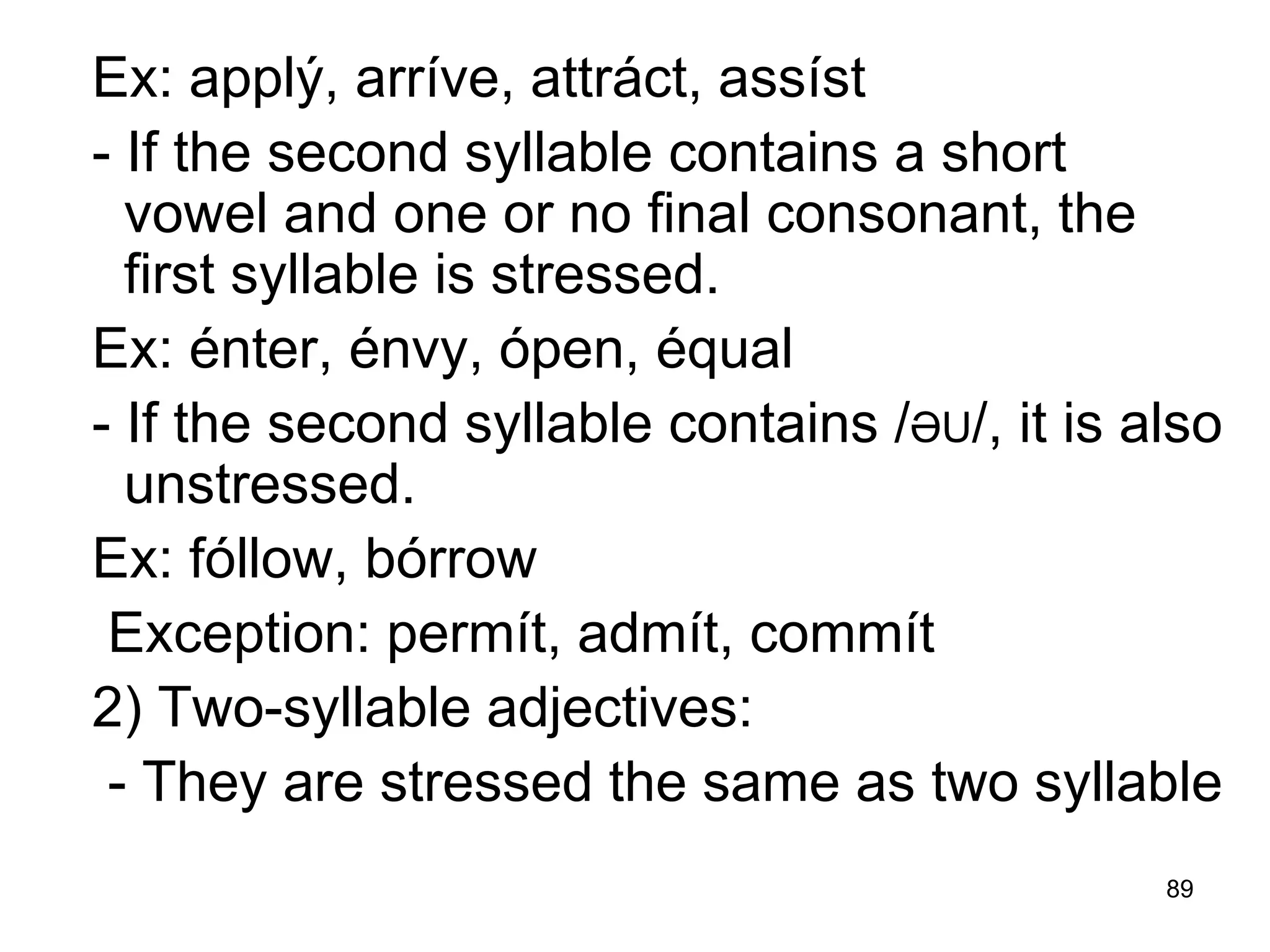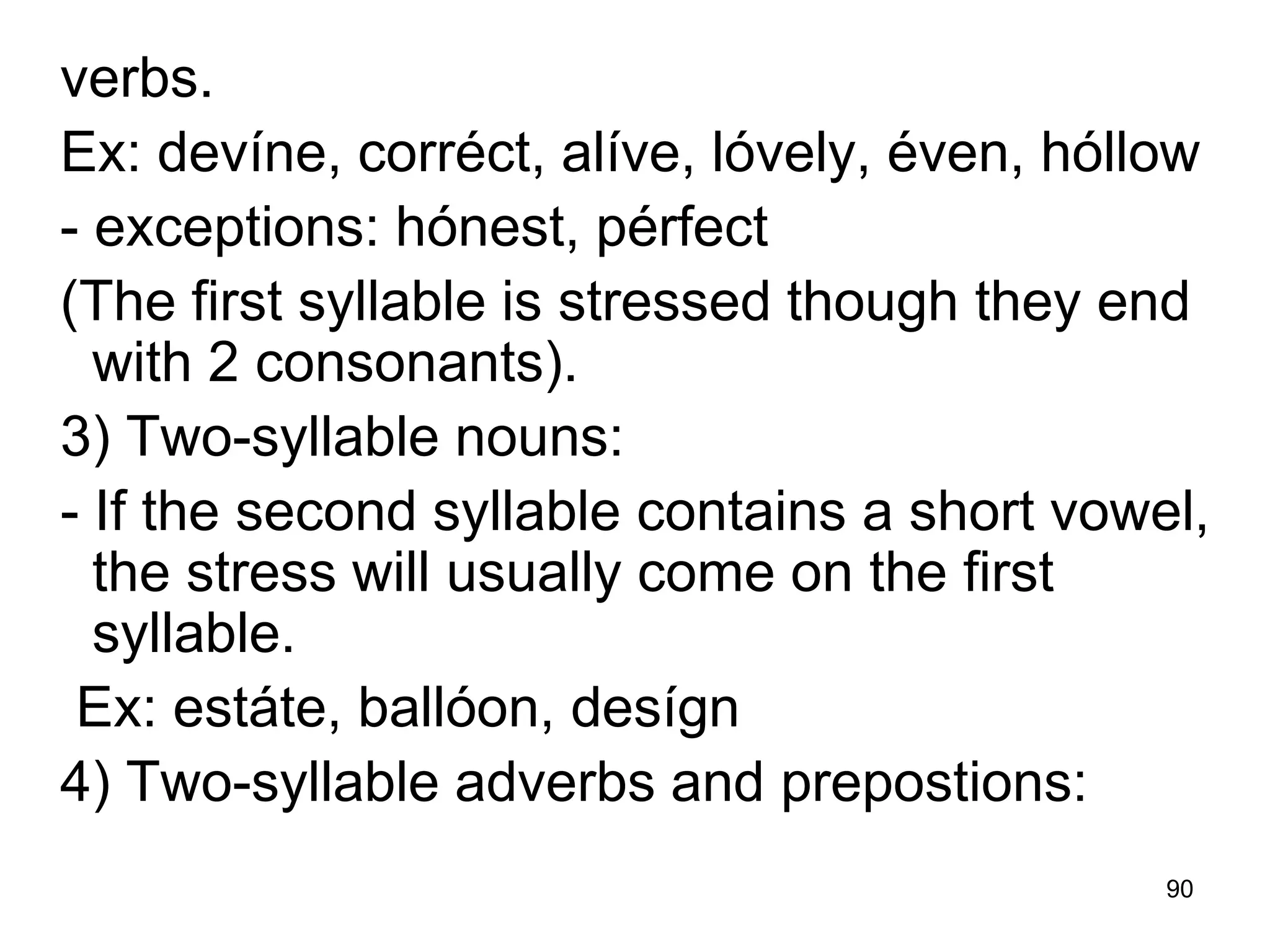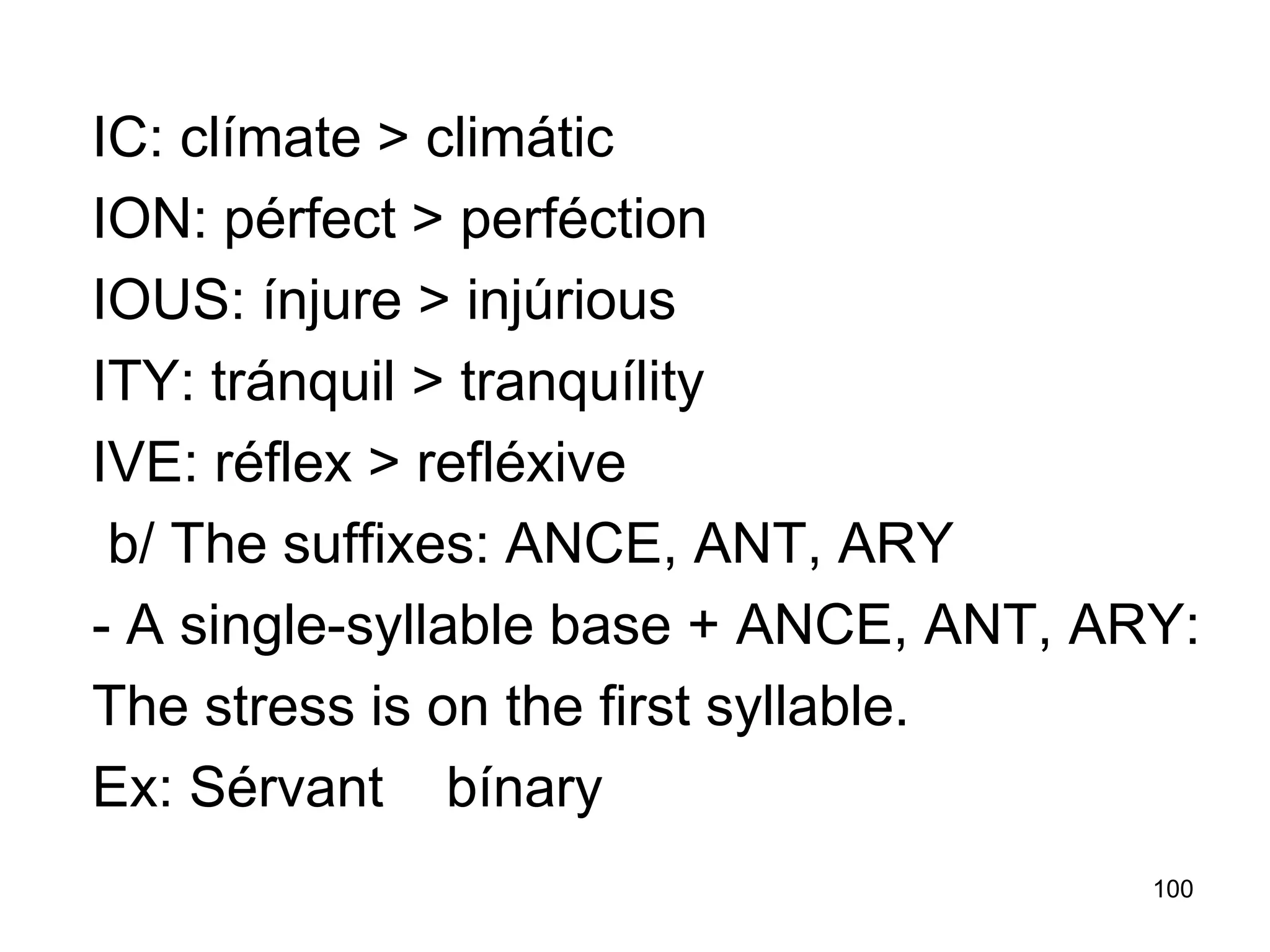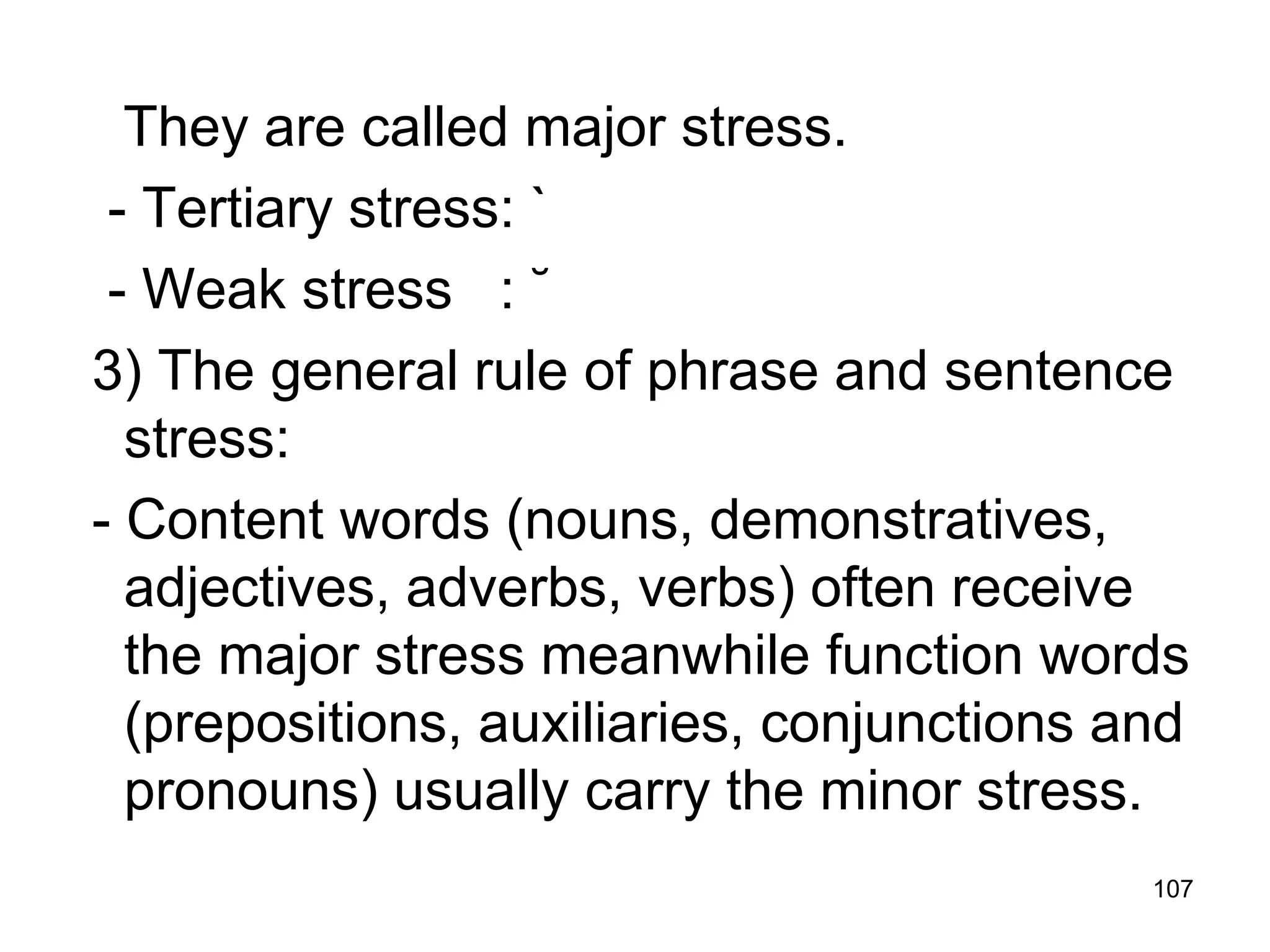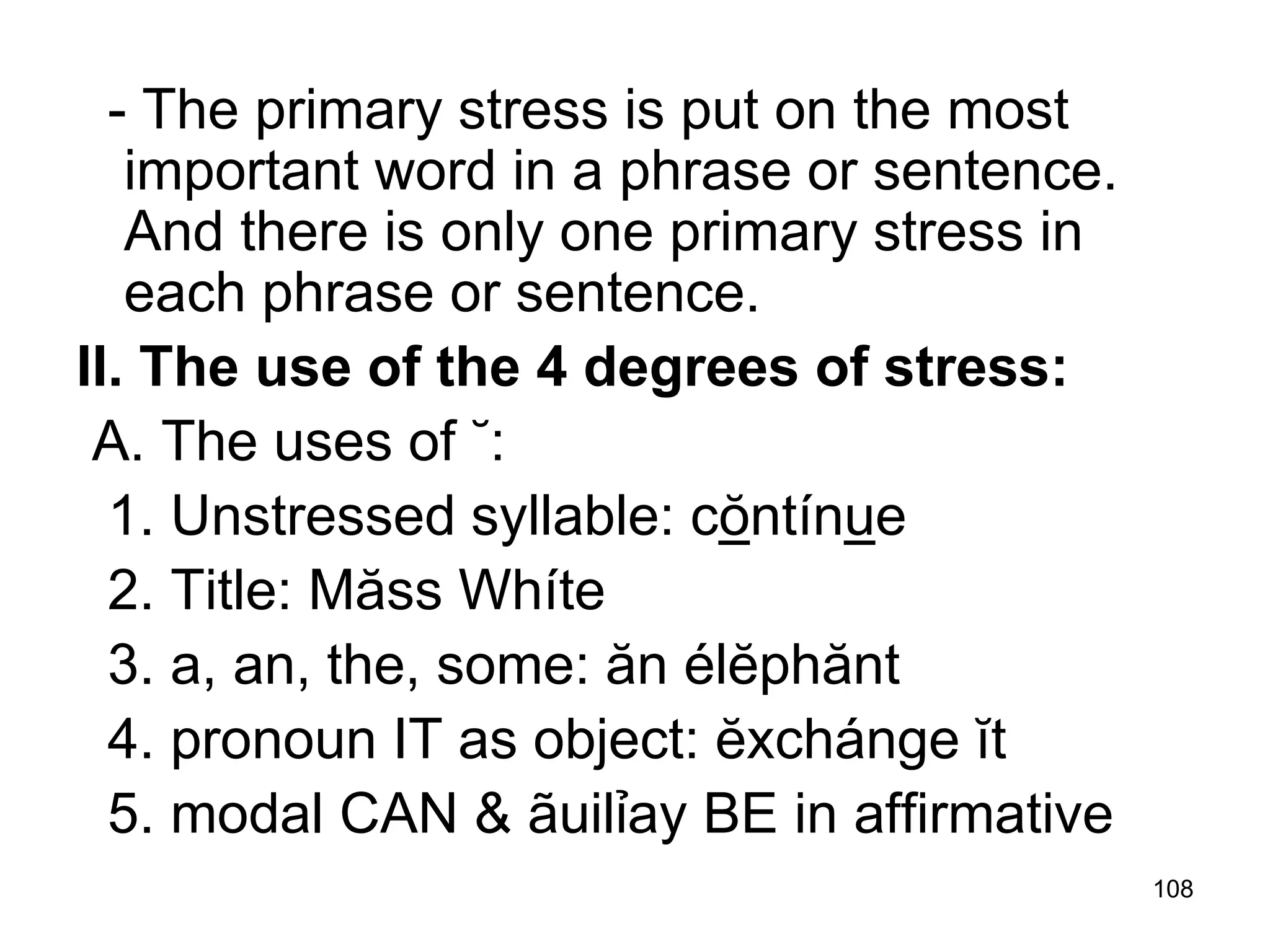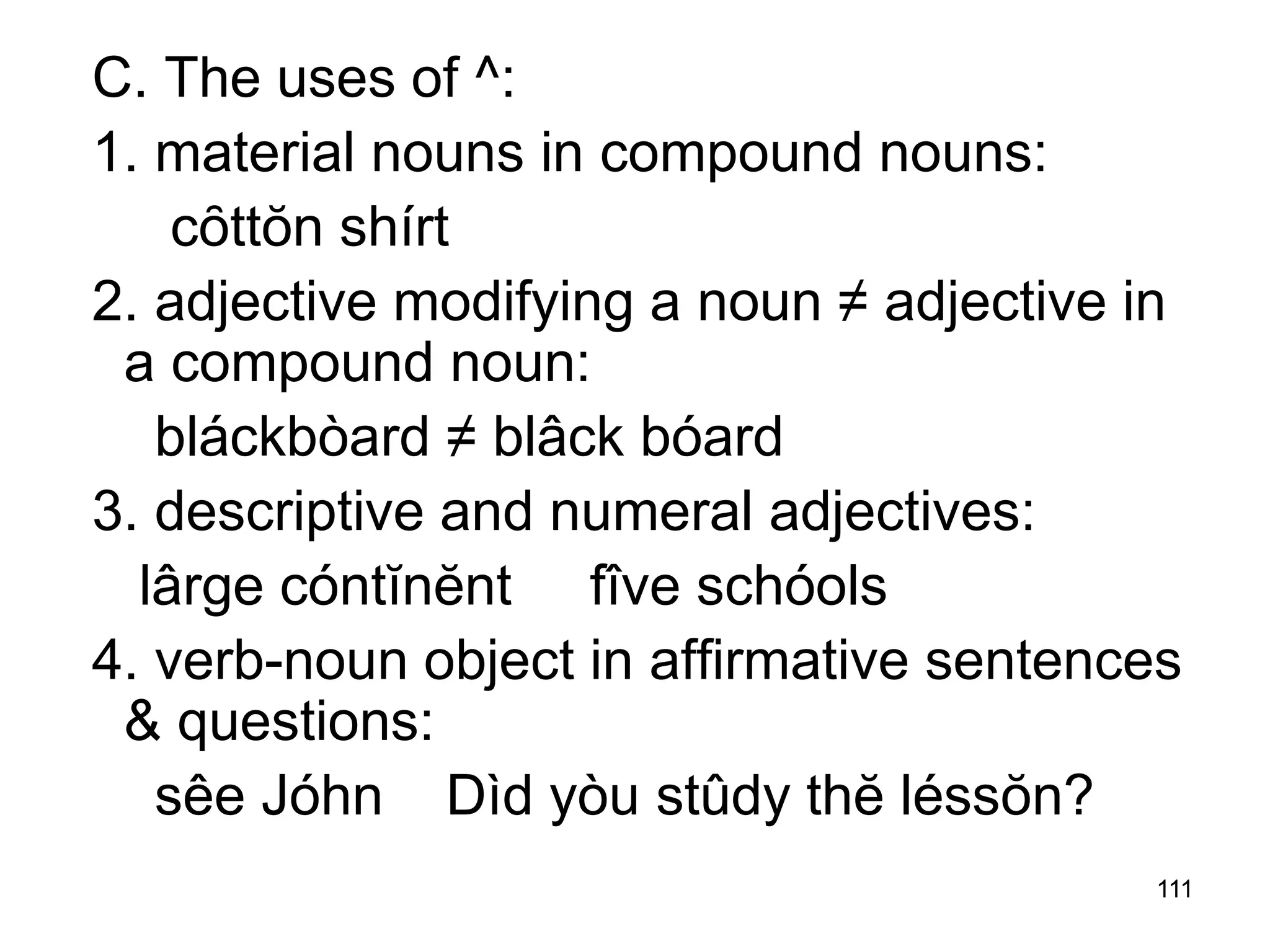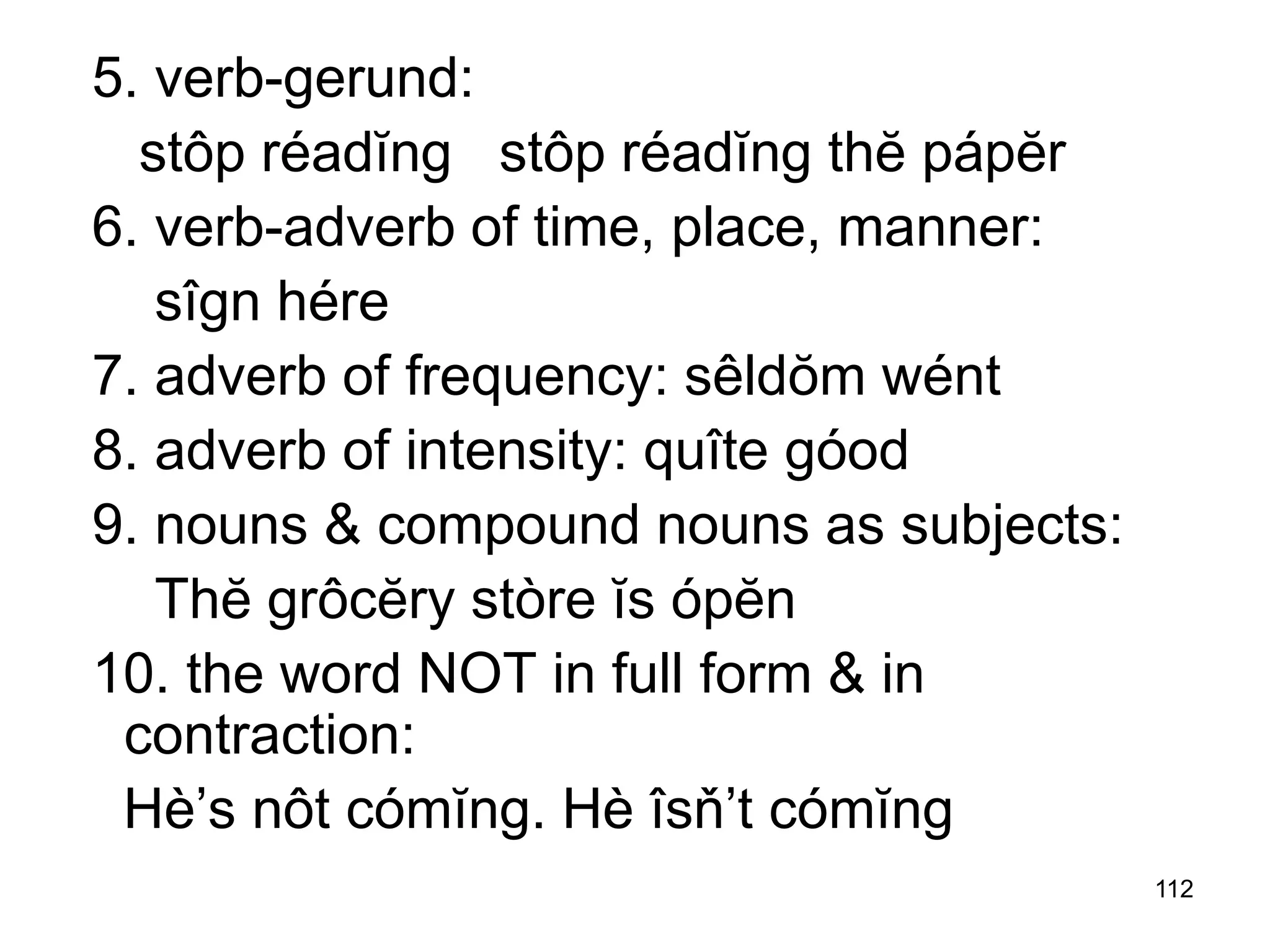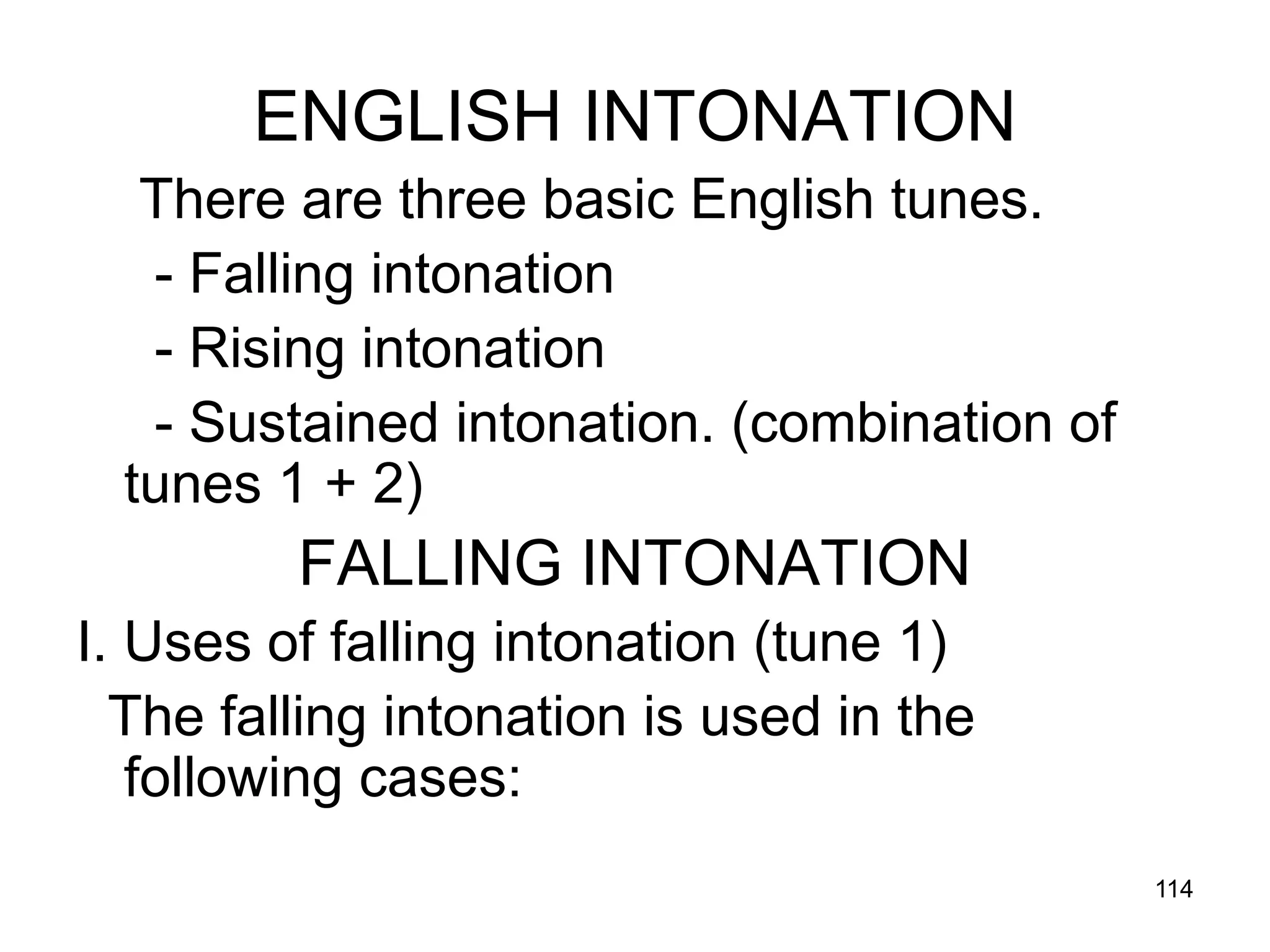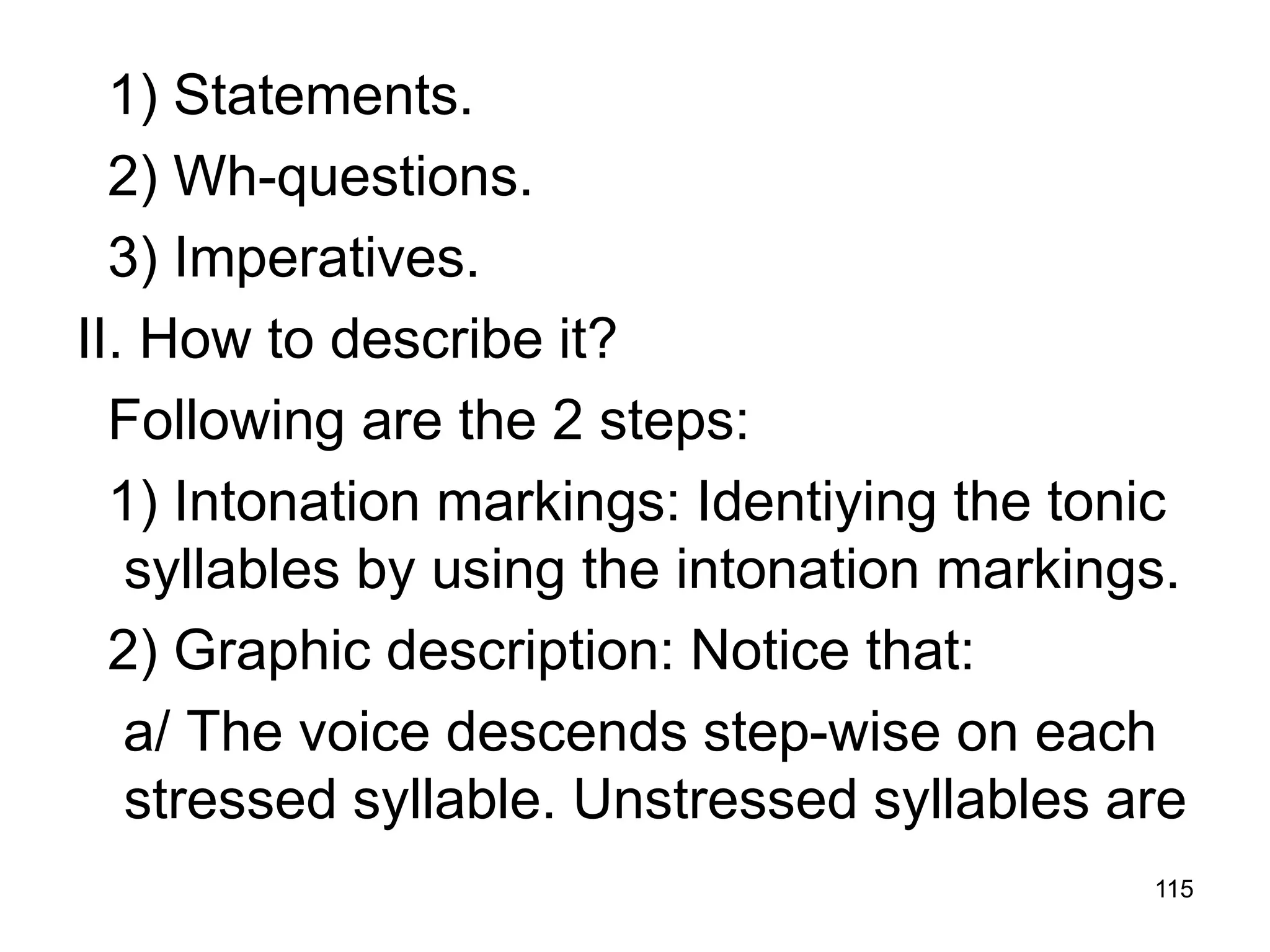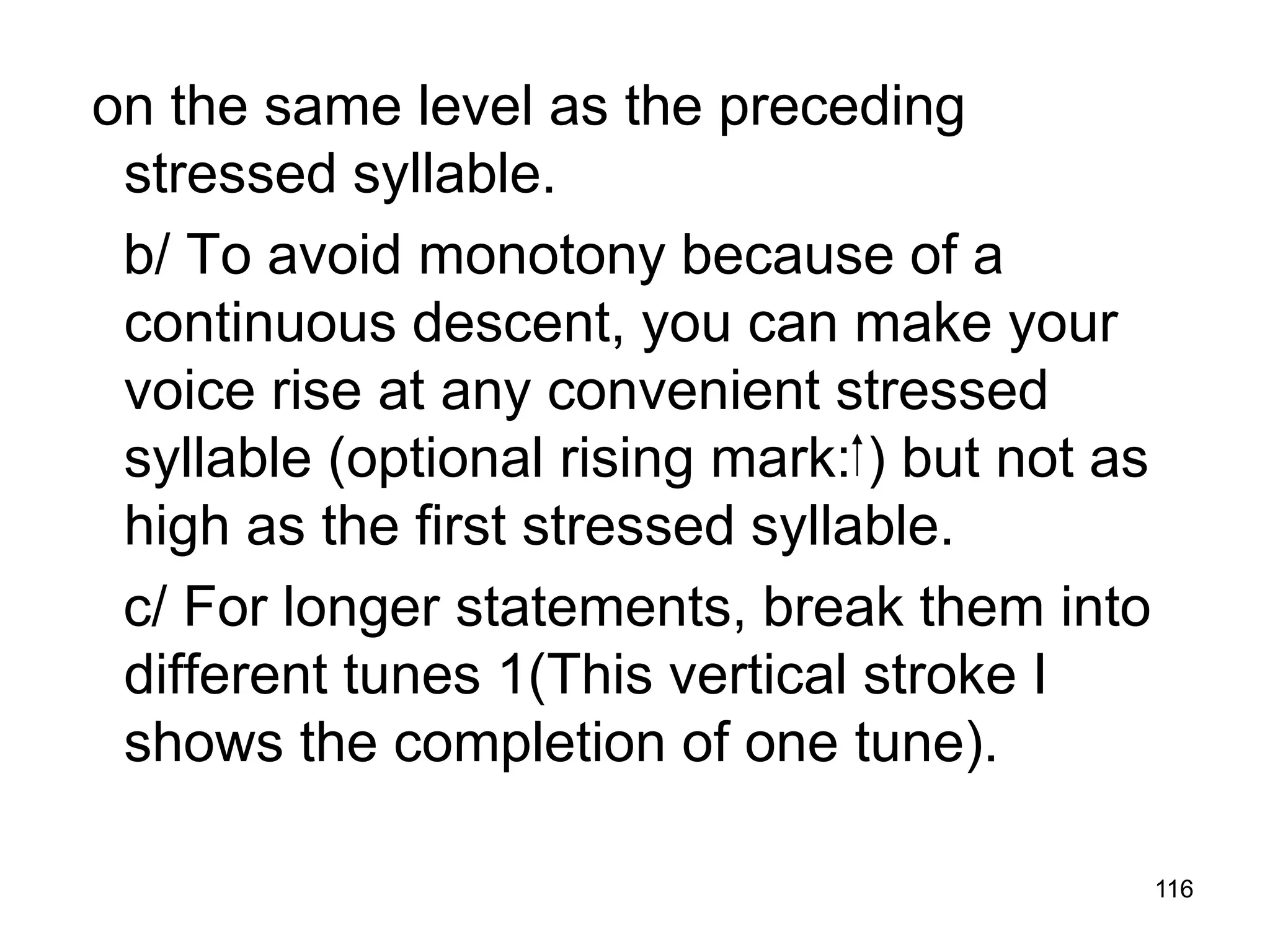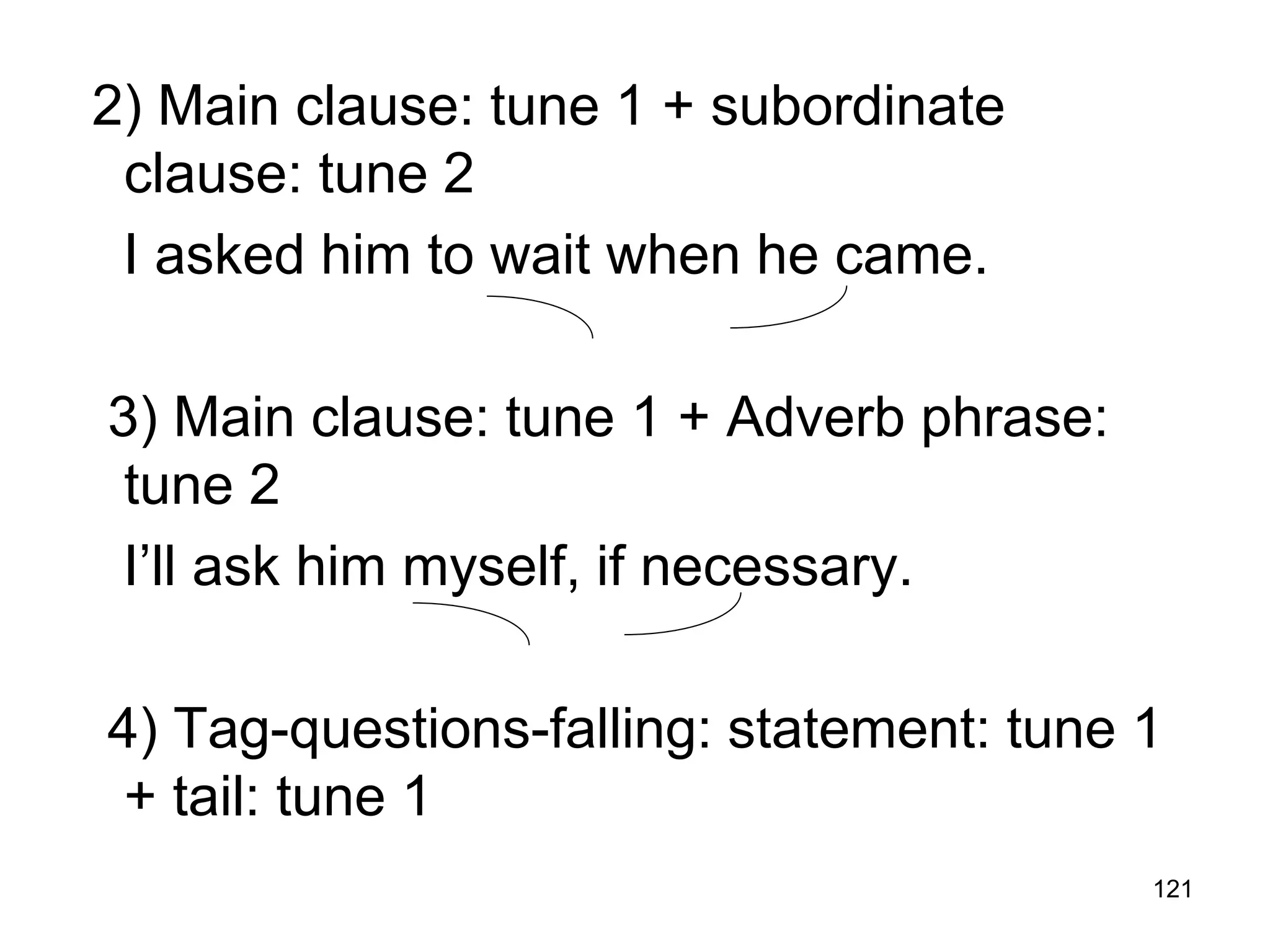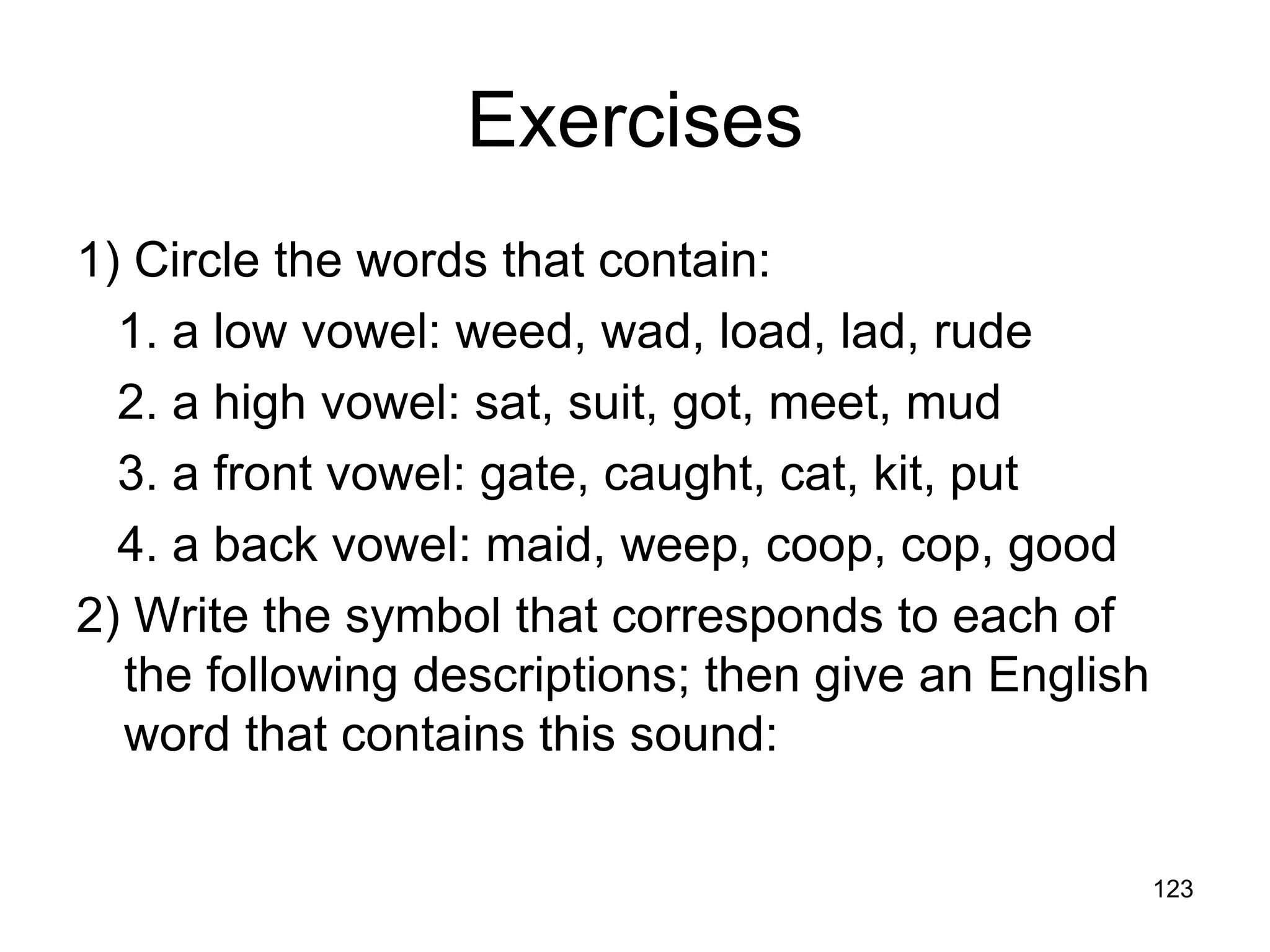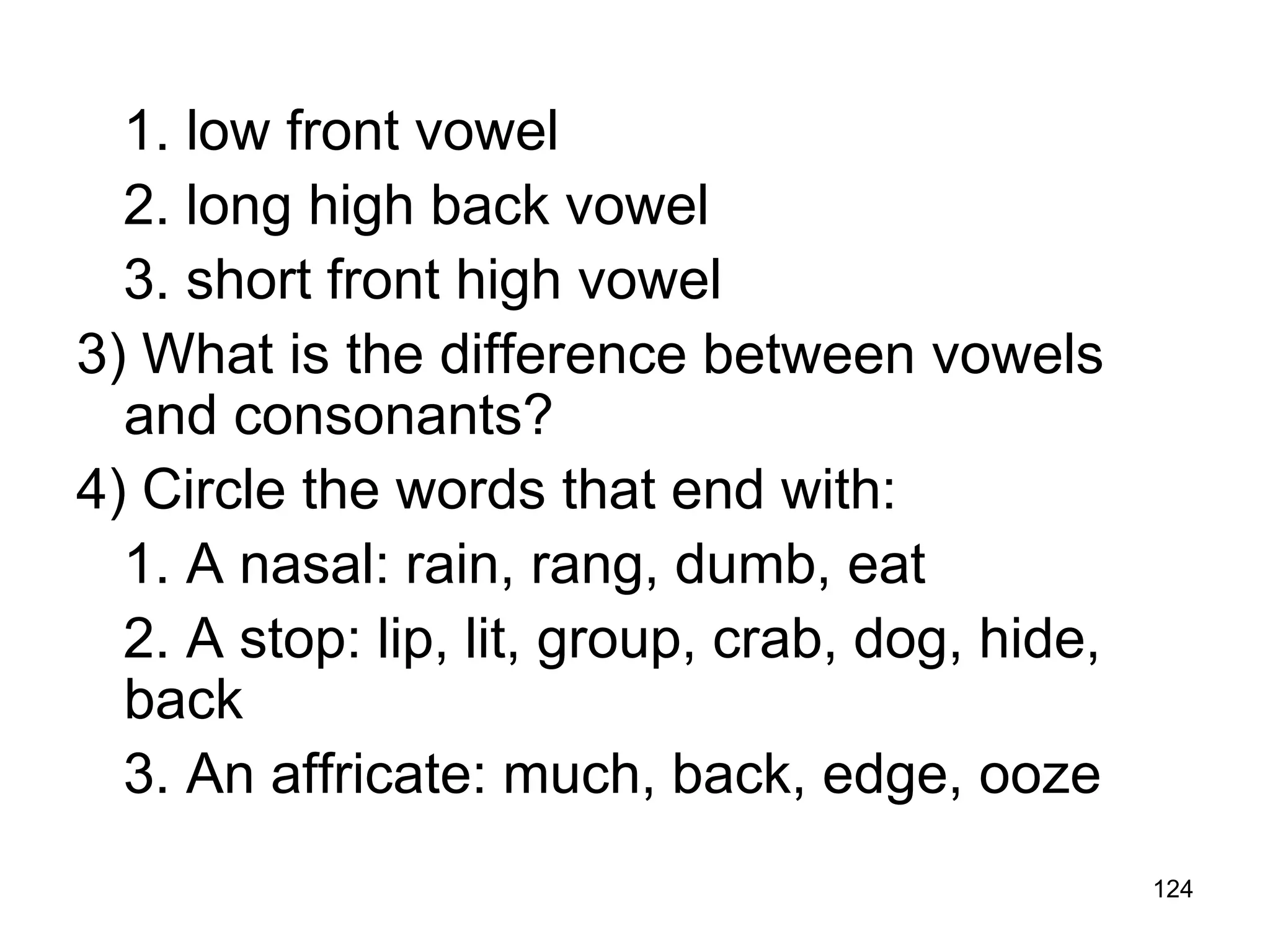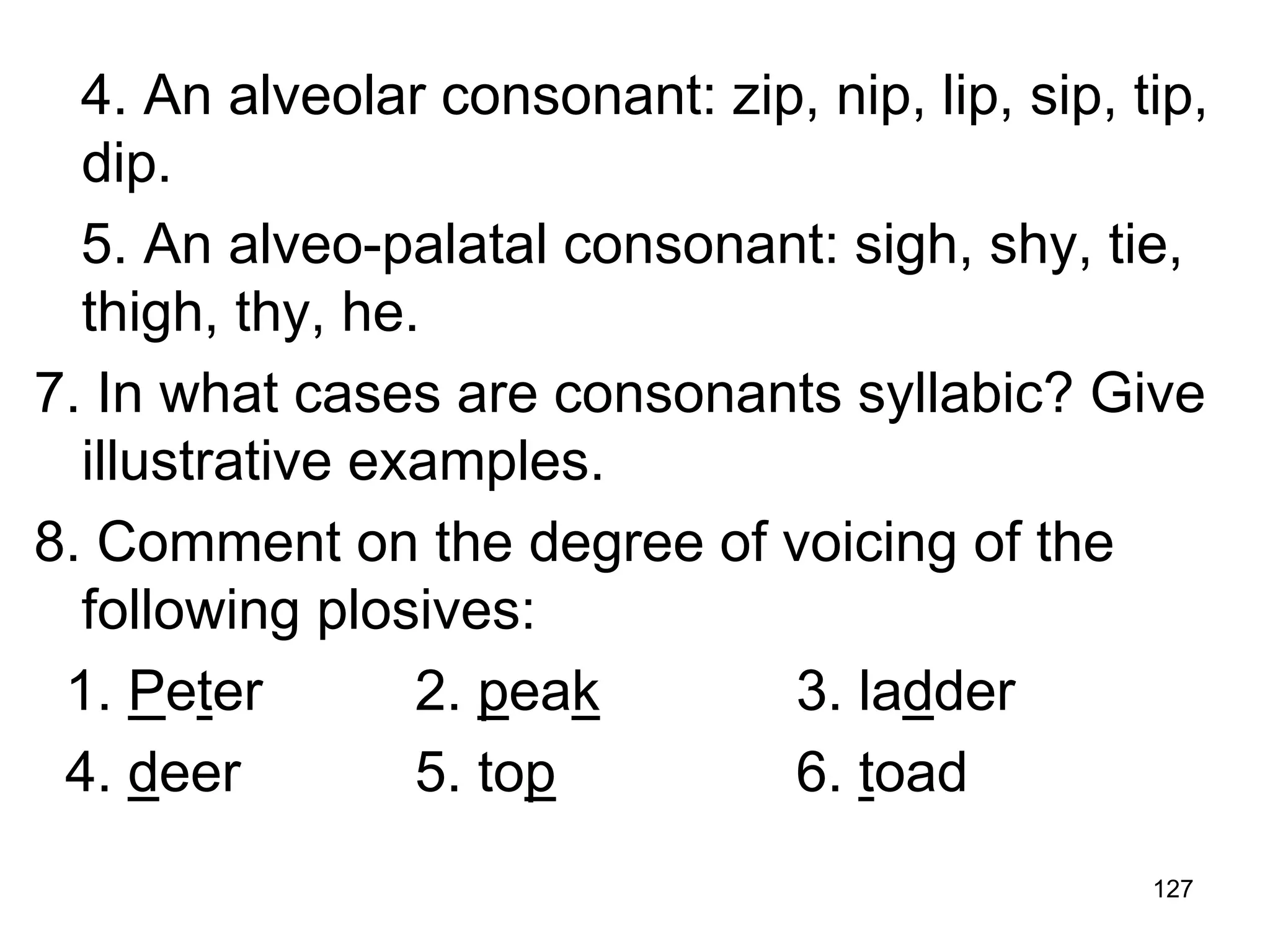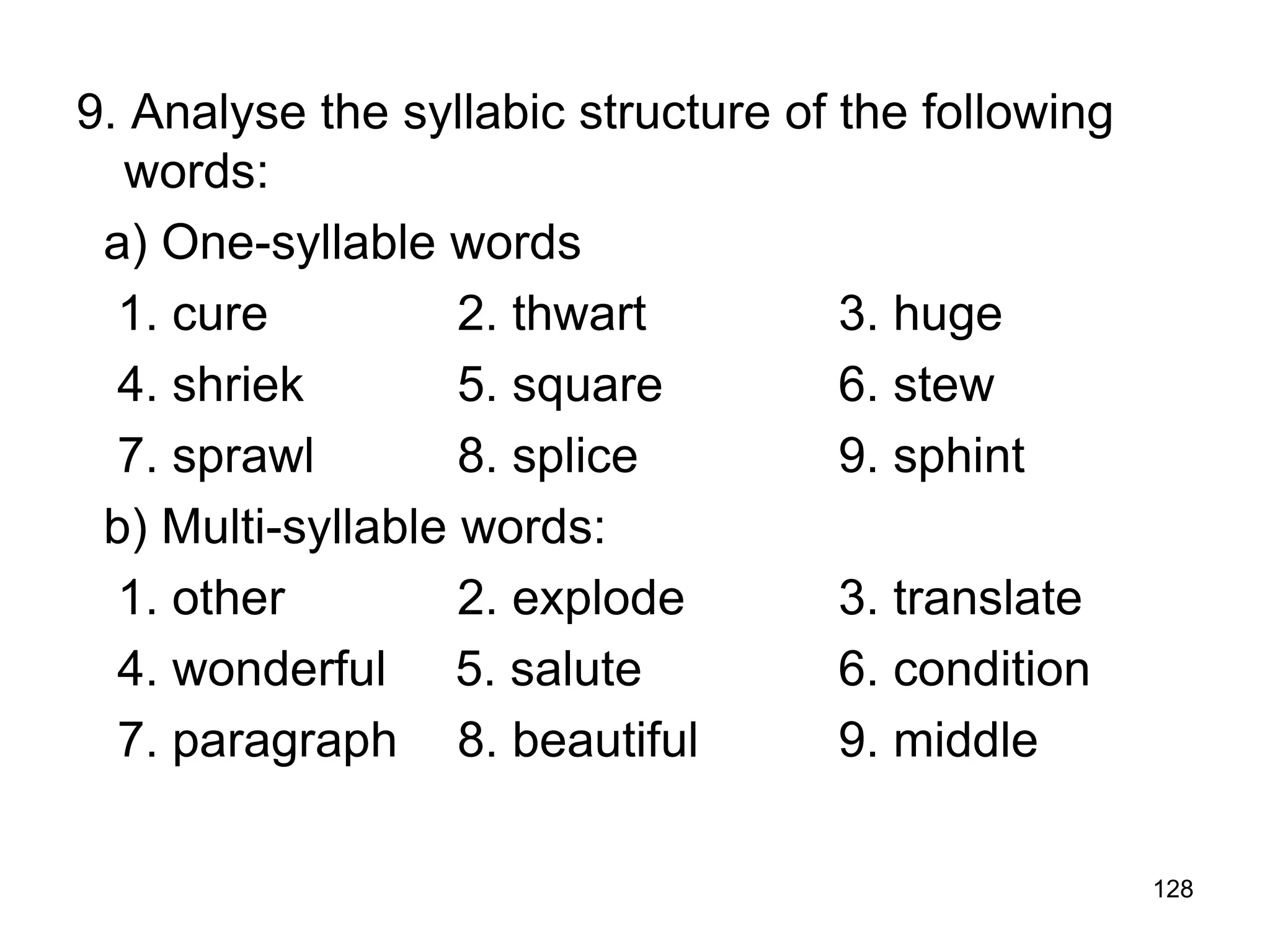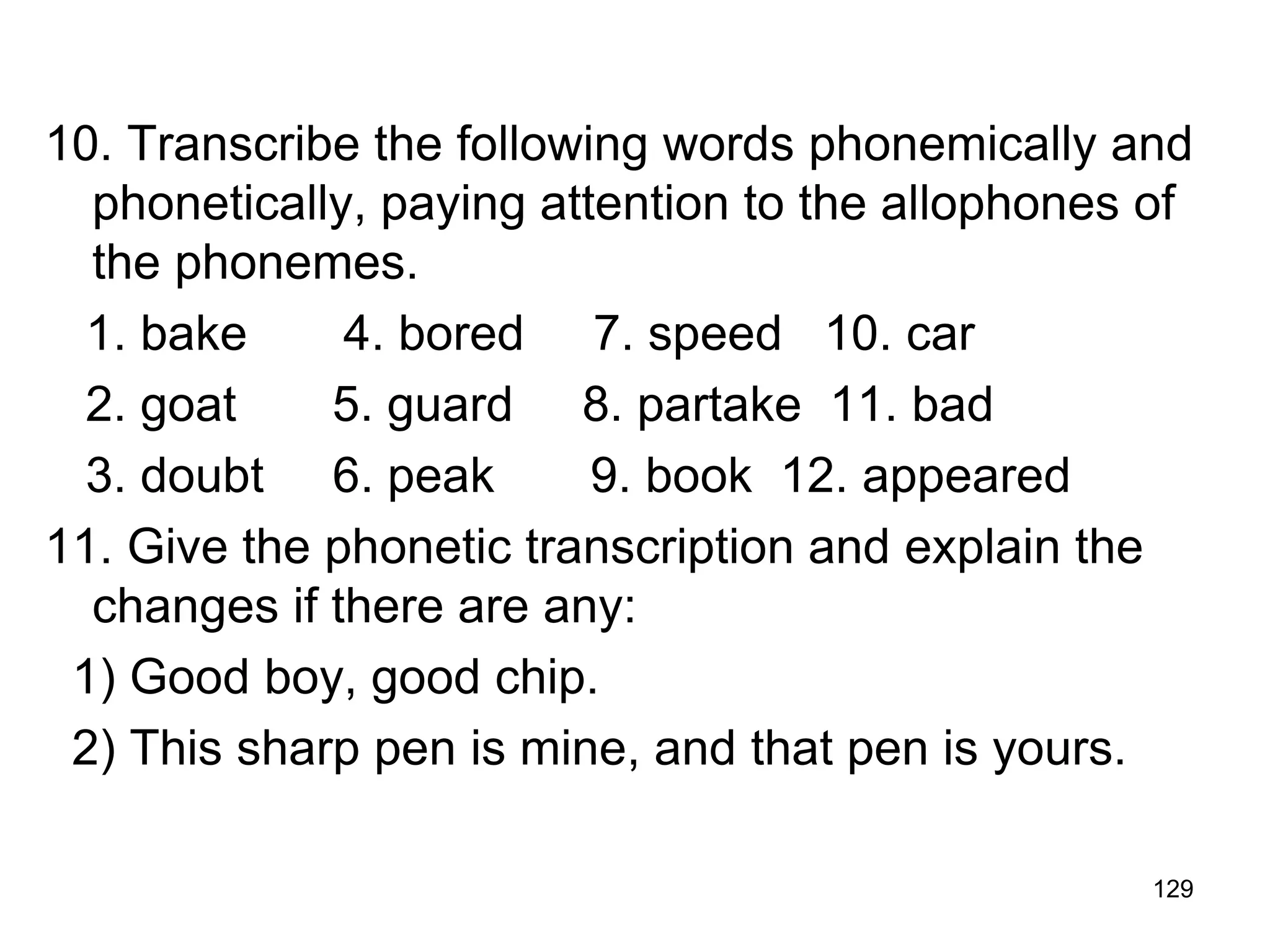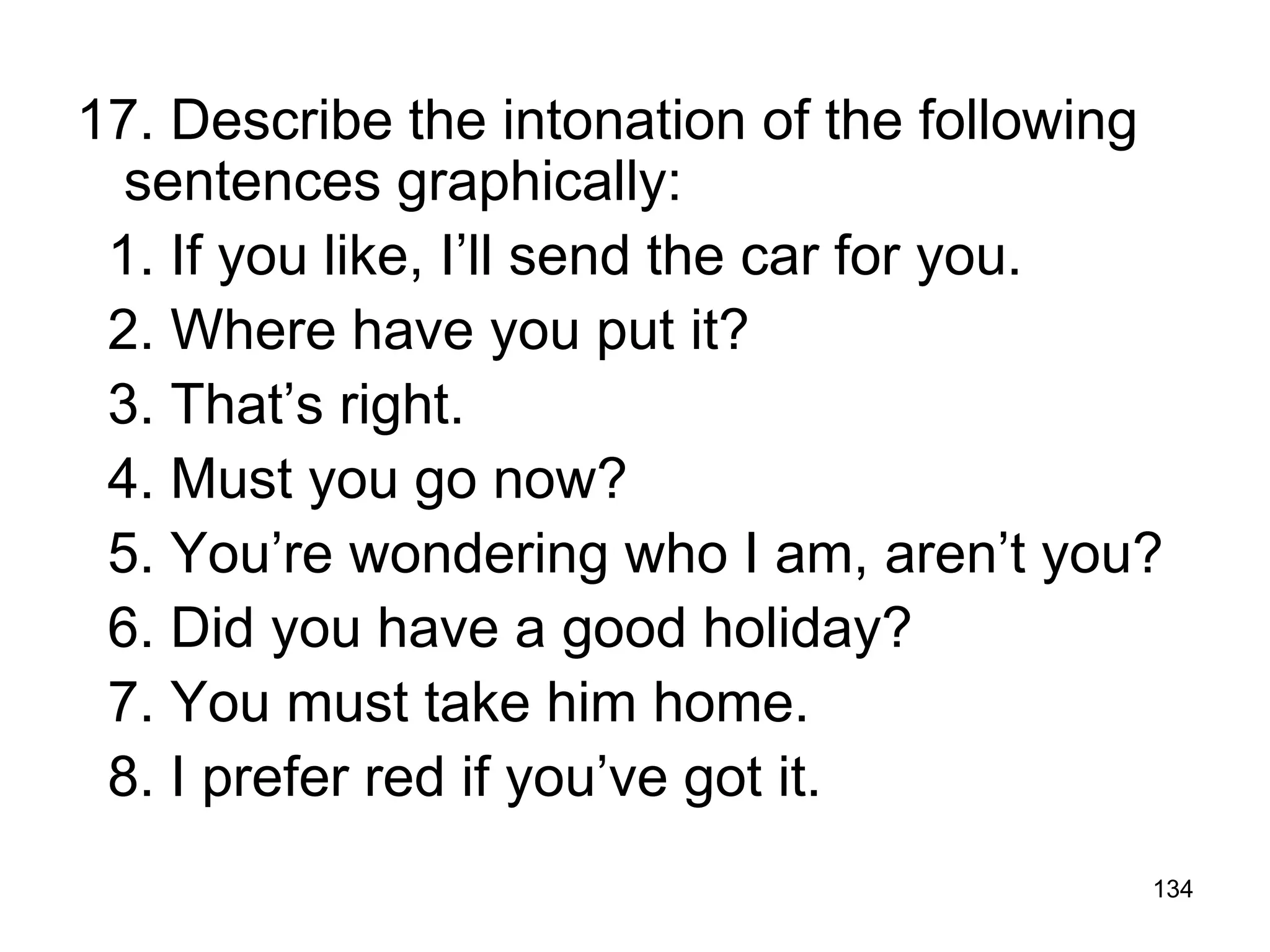This document provides an overview of phonetics and phonology. It begins by defining phonetics as the physical aspect of sounds and phonology as including phonetic transcription with allophones. It then describes the speech organs involved in sound production, including the vocal cords, pharynx, tongue, uvula, teeth, and lips. It classifies vowels and consonants according to their place and manner of articulation. It discusses vowel height, position, rounding, and length. For consonants, it covers voicing, aspiration, plosives, fricatives, affricates, nasals, laterals, and glides. It also discusses syllabic consonants, fortis and lenis conson






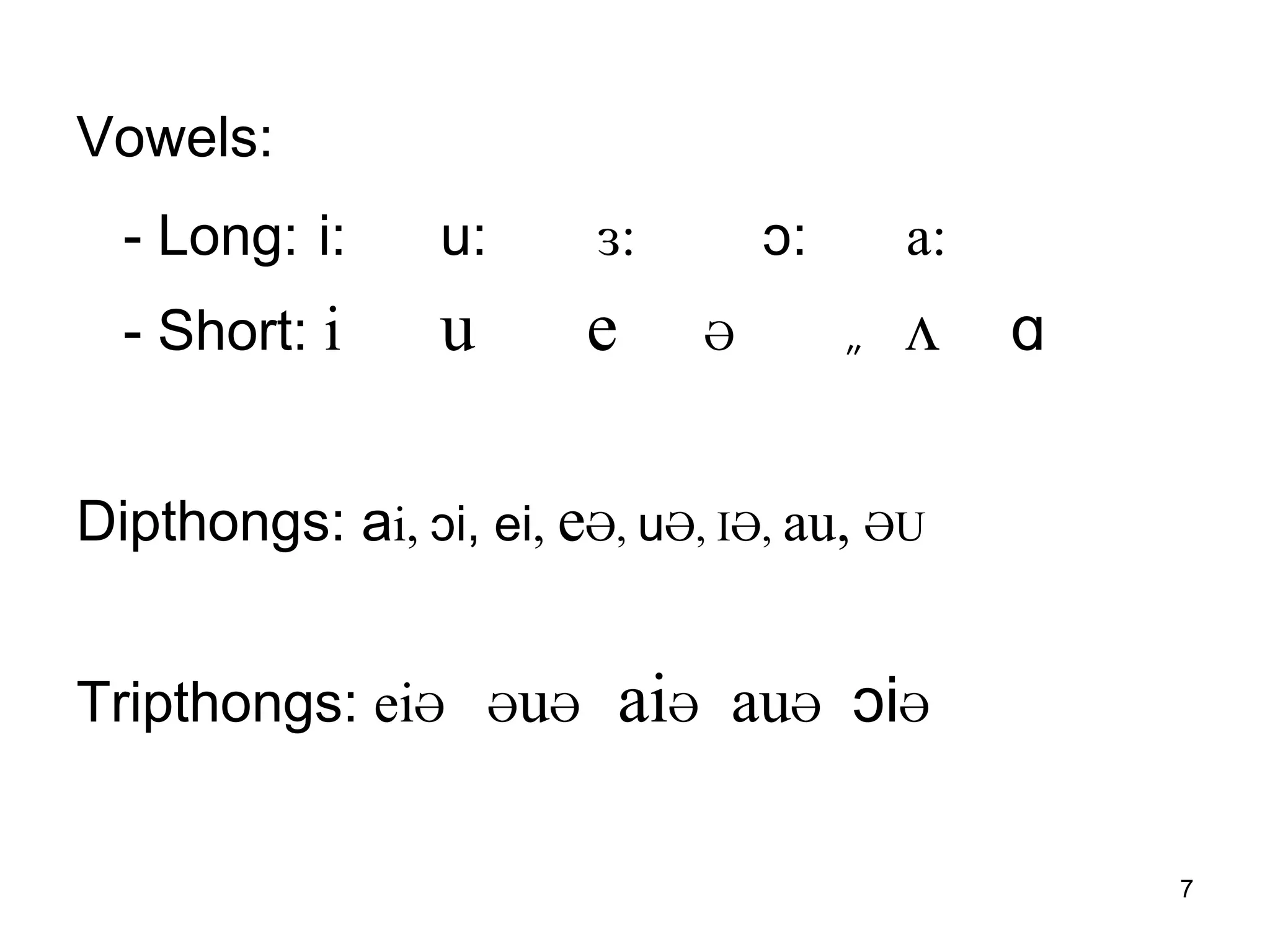













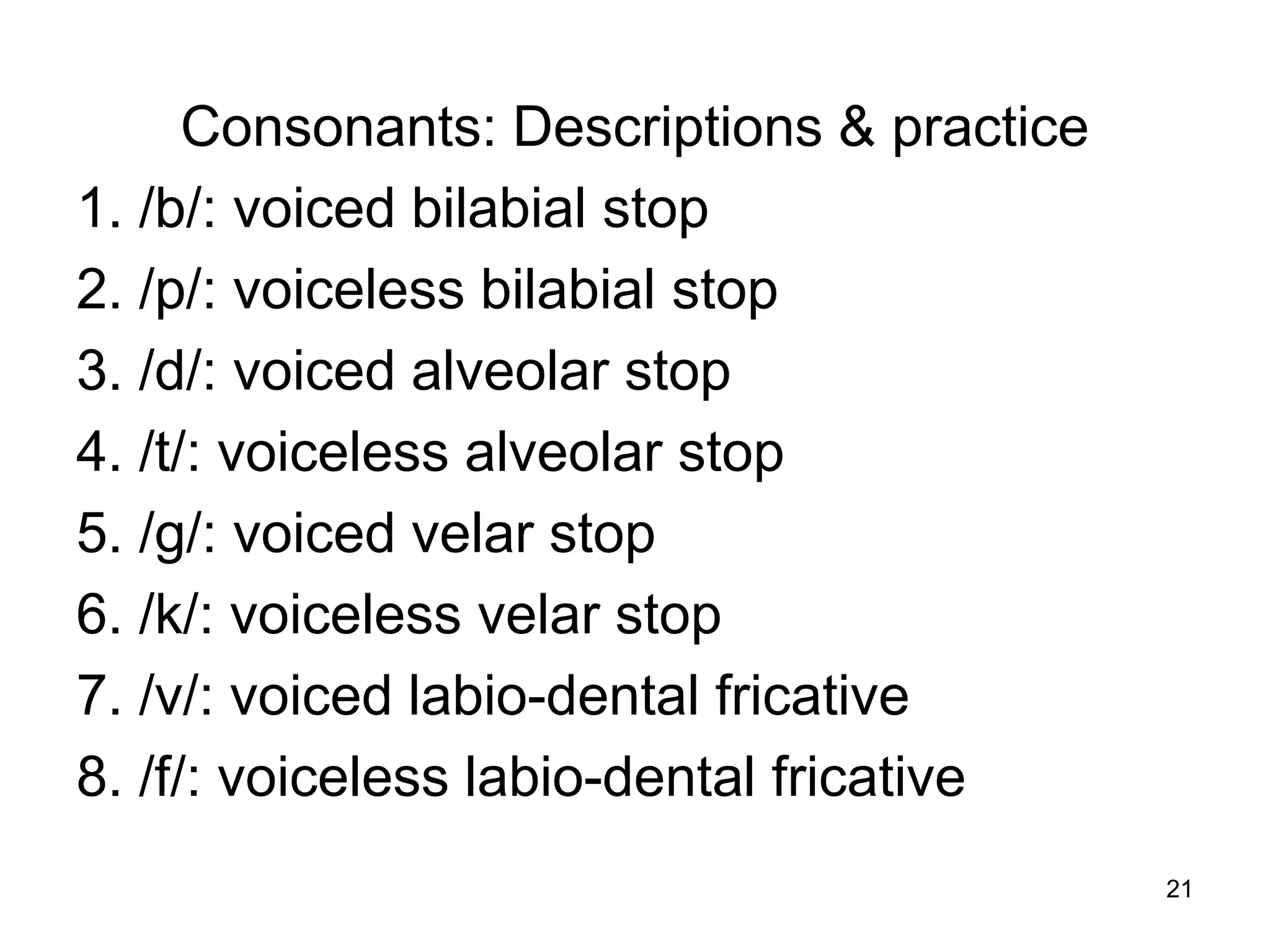



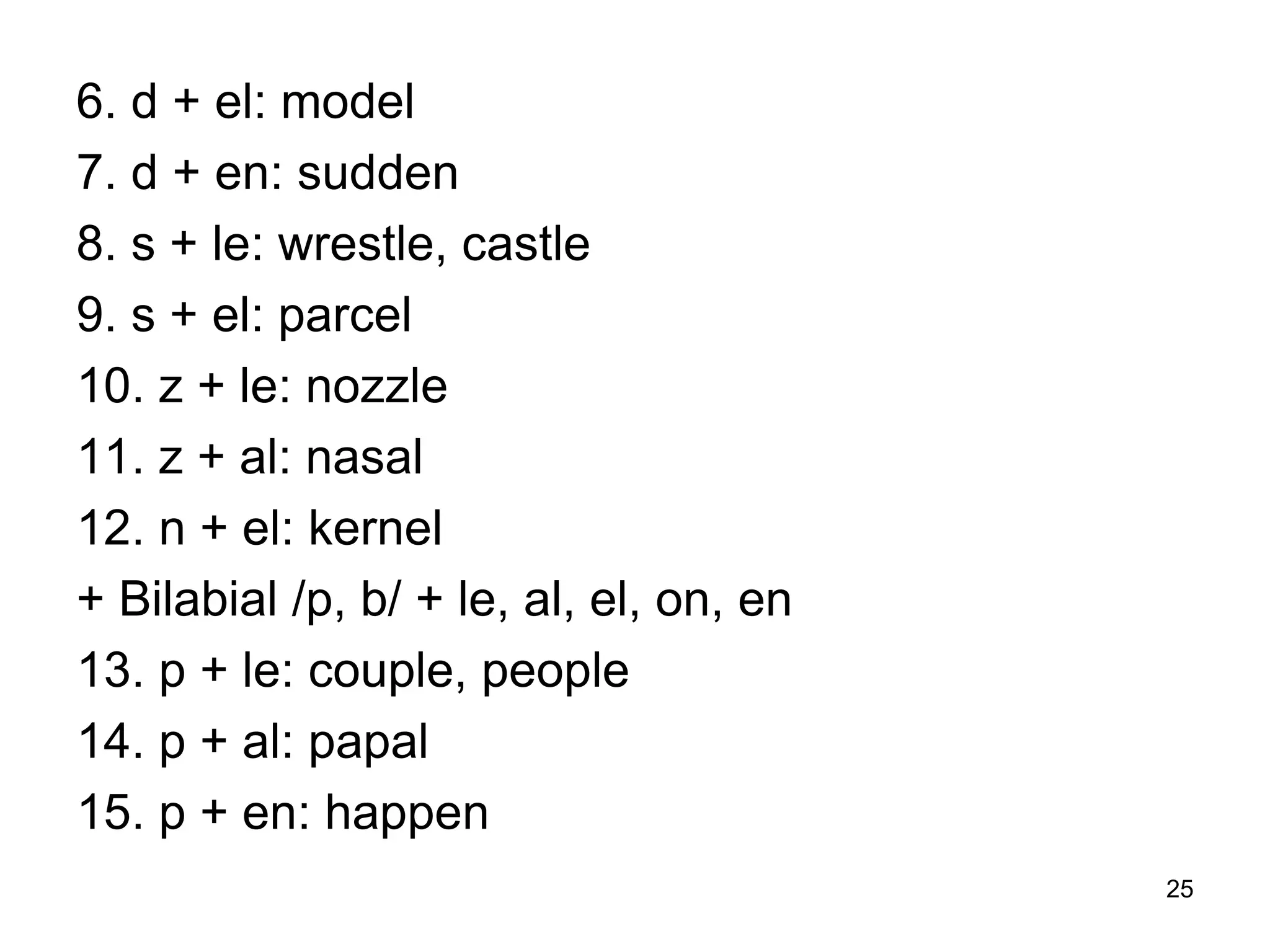


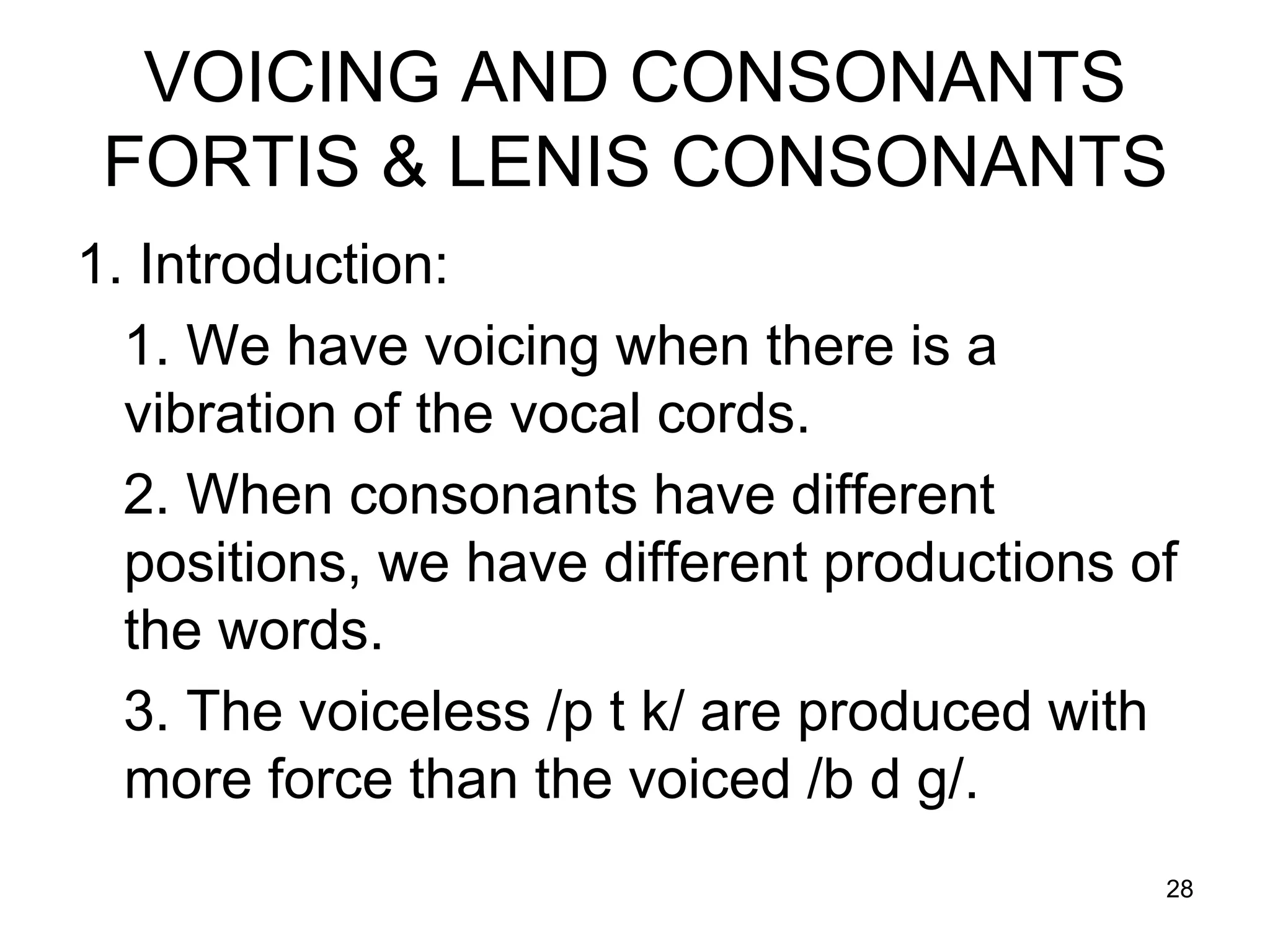
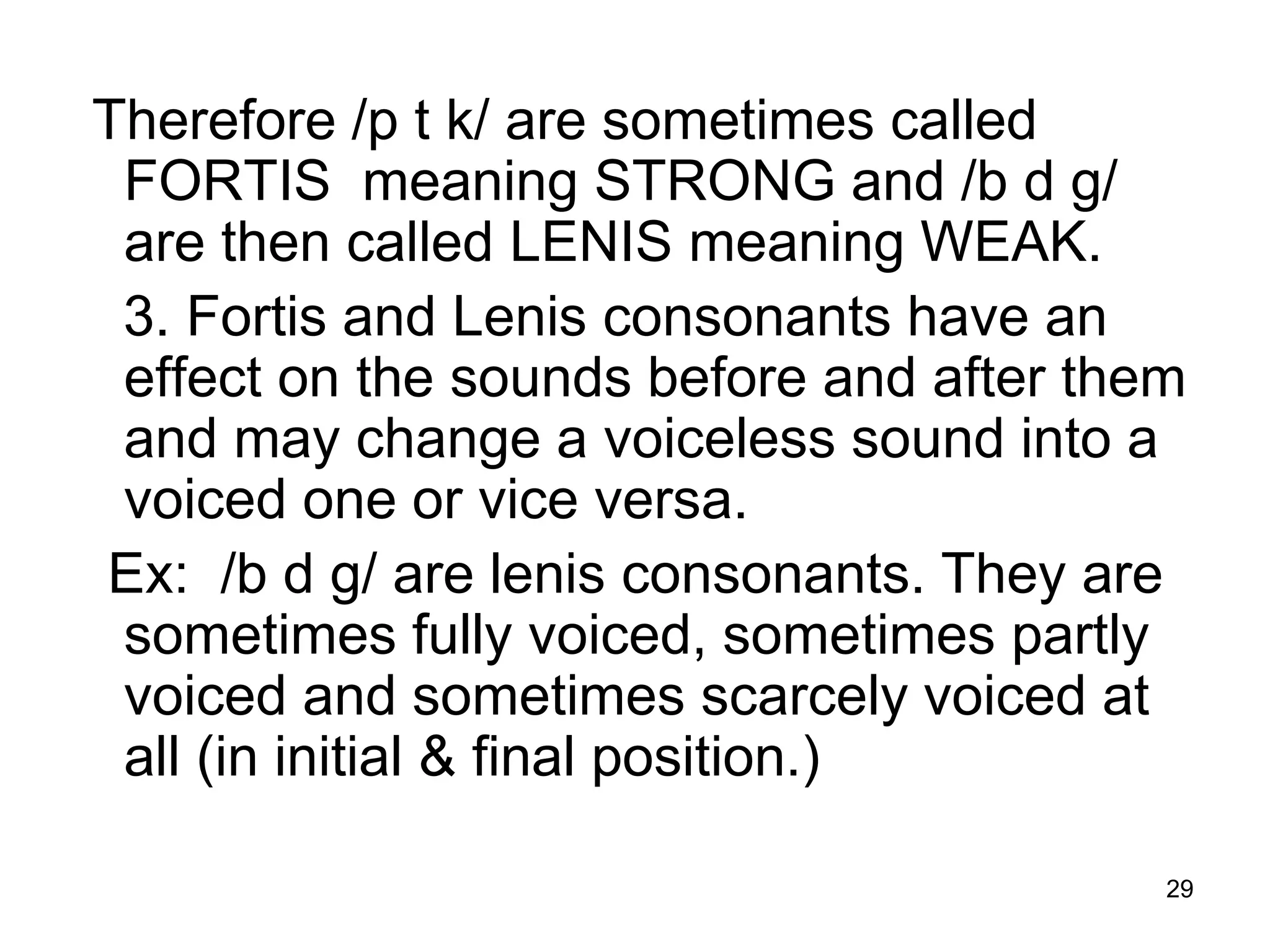



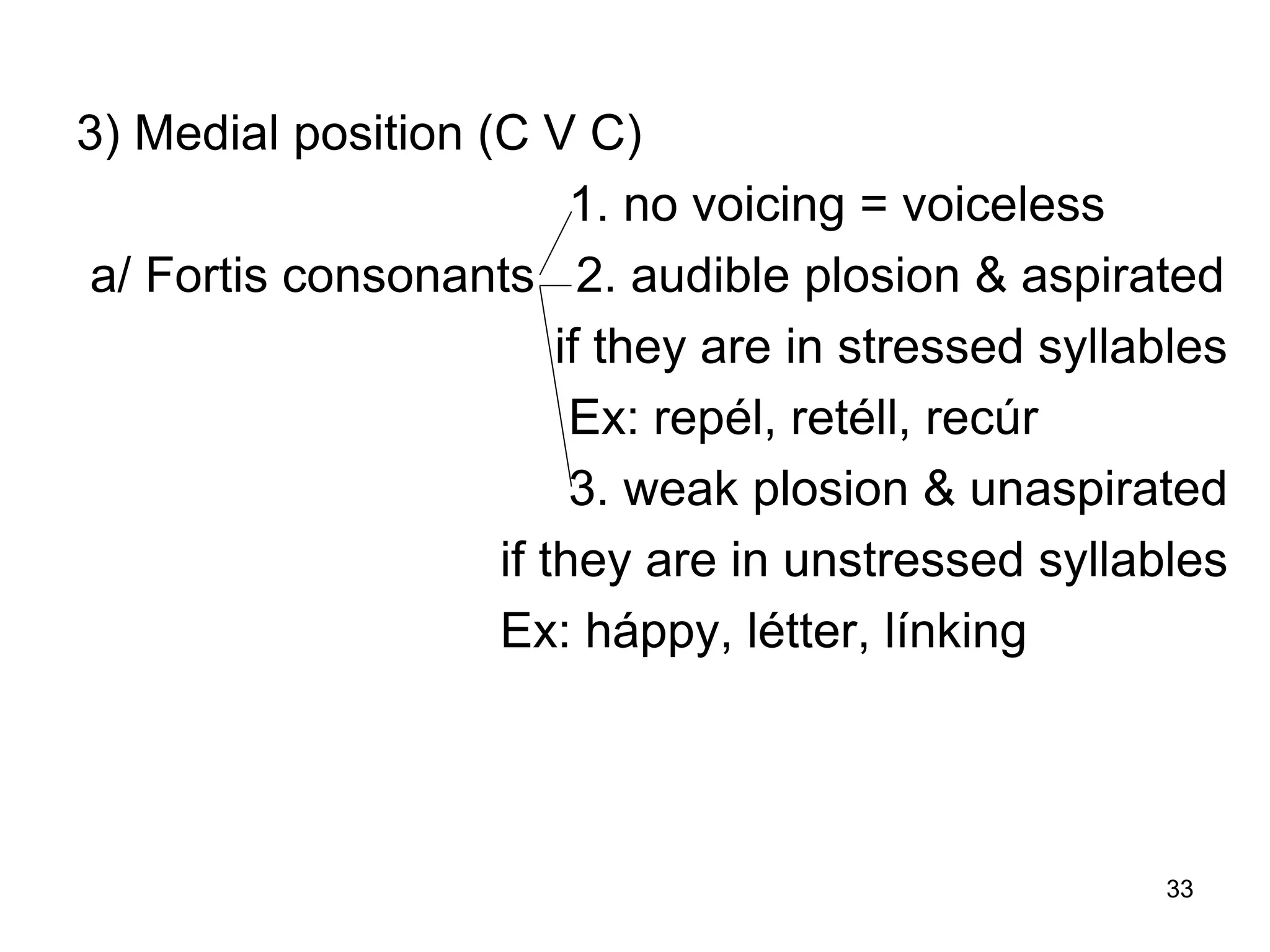
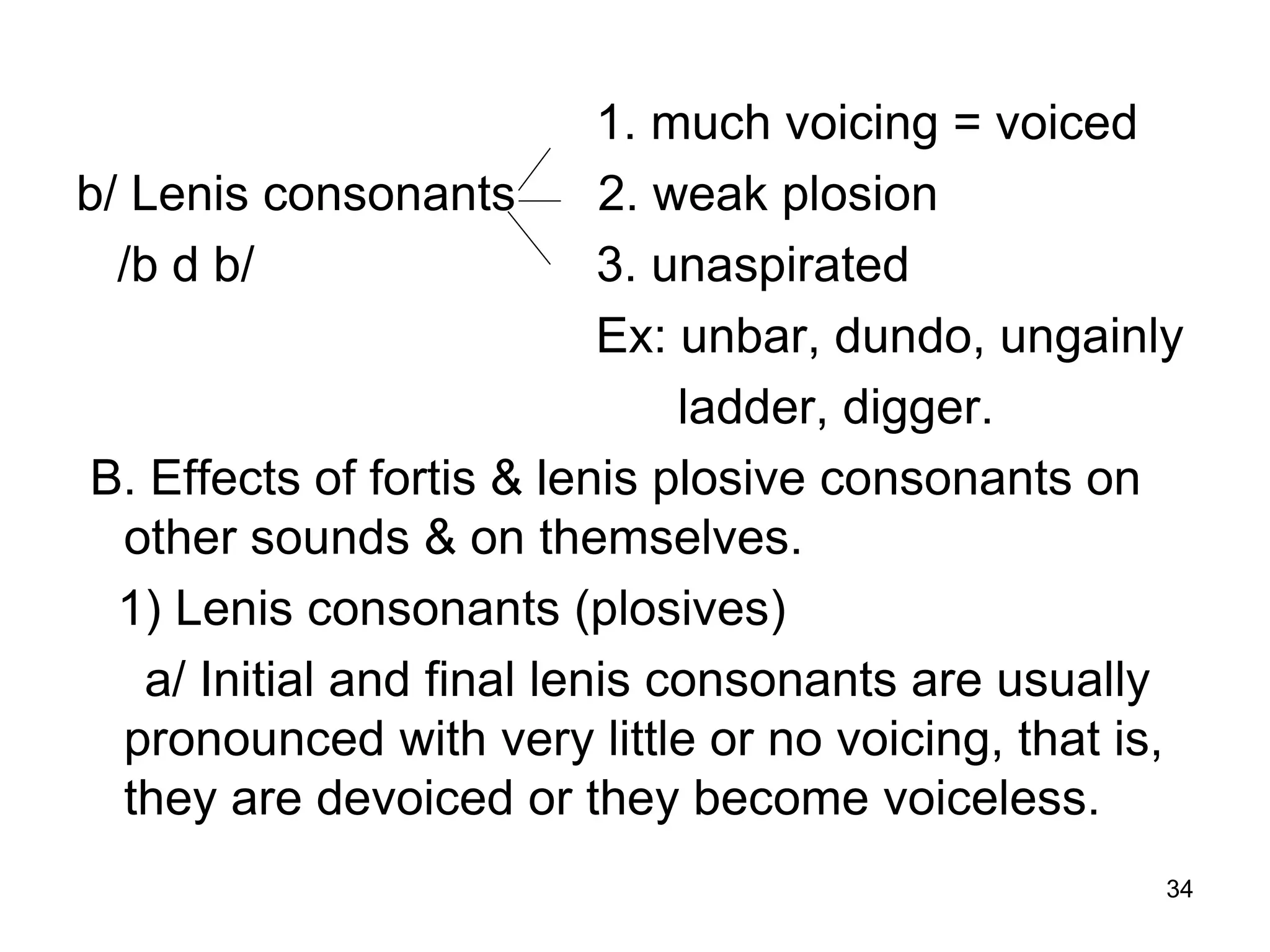
![35
Ex: deer, green, bee, need, tab, league
b/ However, they are usually fully voiced in medial
position, especially when they are surrounded
by voiced sounds.
Ex: elbow, unbar, undo, ungainly
2) Fortis consonants (plosives)
a/ Final fortis consonants shorten their preceding.
+ Vowels: plate [phleit], bark [ba:k]
+ Continuant consonants l, m, n:
belt [belt], bump [bʌmp], bent [bent], bank [b„ŋk]](https://image.slidesharecdn.com/phoneticsandphonology-220416124040/75/Phonetics-and-Phonology-ppt-35-2048.jpg)
![36
b/ Initial fortis consonants make their following
vowels which are always voiced continuant
consonant (r w j) lose their voicing:
+ Initial fortis aspirated consonants + partly
devoiced vowels.
Ex: Put [phut]
+ Initial fortis aspirated consonant + devoiced (l r
w j)
Ex: play [phlei], tray [threi], quick [khwik], cue
[khju:], straight [streit].](https://image.slidesharecdn.com/phoneticsandphonology-220416124040/75/Phonetics-and-Phonology-ppt-36-2048.jpg)
![37
+ Initial fortis unaspirated consonant + devoiced (l
r w j)
Ex: splendid [‘splendid] spread [spred]
square [skweƏ], skewer [skju:Ə]
C. The English fricative:
There are nine:
1. are voiceless
1) Fortis fricatives 2. are articulated with greater
/f θ s ʃ/ force than the lenis ones and
their friction noise is louder.
3. shorten their preceding vowel](https://image.slidesharecdn.com/phoneticsandphonology-220416124040/75/Phonetics-and-Phonology-ppt-37-2048.jpg)
![38
Ex: laugh [laf], death [deθ], kiss [kis], bush [buʃ]
1. are pronounced with very little
or no voicing (are devoiced or
become voiceless
- in initial position (CV)
2) Lenis fricatives Ex: vet [vet], this [δis], zoo [zu:]
/v δ z ʒ/ - in final position (CV)
Ex: five [faiv], booth [ bu:δ]
dose [dƏU z], beige [beiʒ]
2. are fully voiced in medial
position (VCV)](https://image.slidesharecdn.com/phoneticsandphonology-220416124040/75/Phonetics-and-Phonology-ppt-38-2048.jpg)
![39
Ex: television [thelƏviʒn], closet [klƏU zit]
breathing [bri:δiŋ], closure [khlƏU zƏ]
1. when h occurs between
3) The glottalfricative h voiced sounds: ahead,
greenhouse, it is voiced.
2. h + w is a voiceless
fricative: which, whale, why
D) The English Affricates ʧ & ʤ
1. are voiced sounds.
ʧ & ʤ 2. Initial ʧ is slightly aspirated
3. Final ʧ shortens its preceding vowels.](https://image.slidesharecdn.com/phoneticsandphonology-220416124040/75/Phonetics-and-Phonology-ppt-39-2048.jpg)
![40
E) The Lateral l
Devoiced l, follows p or k at the beginning of a
stressed syllable.
Ex: play [phlei], clever [khlevƏ]
F) The Alveo Palatal Aproximant r
1. continuant and voiced
r 2. preceded by p t k at the beginning of a
syllable, it is voiceless and slightly fricative
Ex: press [phres], stress [stres], cress [kres]](https://image.slidesharecdn.com/phoneticsandphonology-220416124040/75/Phonetics-and-Phonology-ppt-40-2048.jpg)
![41
G) The Palatal Approximant j and the Bilabial
Approximant w:
1. continuant & voiced
j & w 2. are devoiced and slightly fricative when
preceded by p t k at the beginning of a
syllable.
Ex: pure /pjuƏ/ [phjuƏ], queue /kju:/ [khju:],
twin /twin/ [thwin], quin /kwin/ [khwin]](https://image.slidesharecdn.com/phoneticsandphonology-220416124040/75/Phonetics-and-Phonology-ppt-41-2048.jpg)
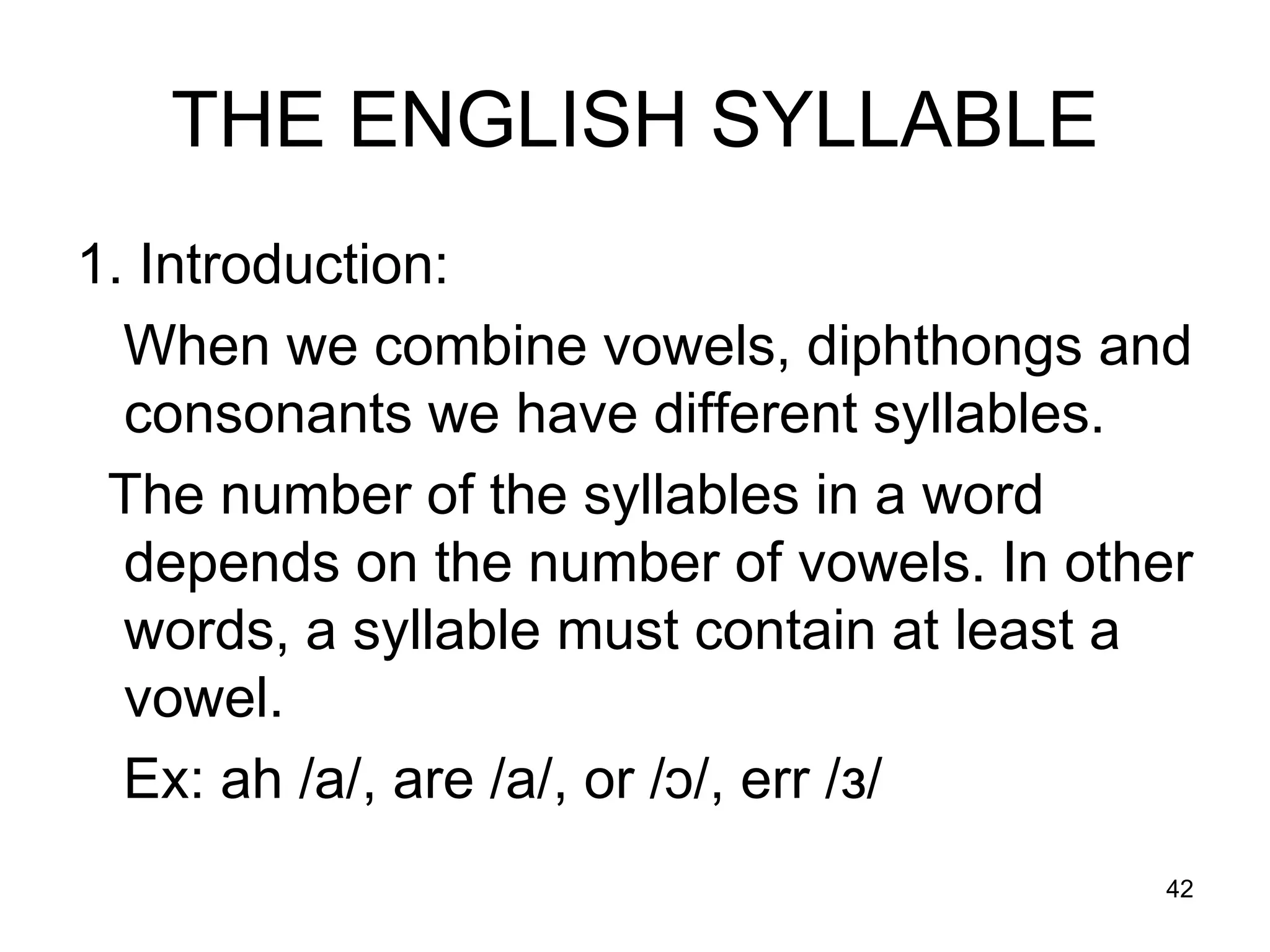


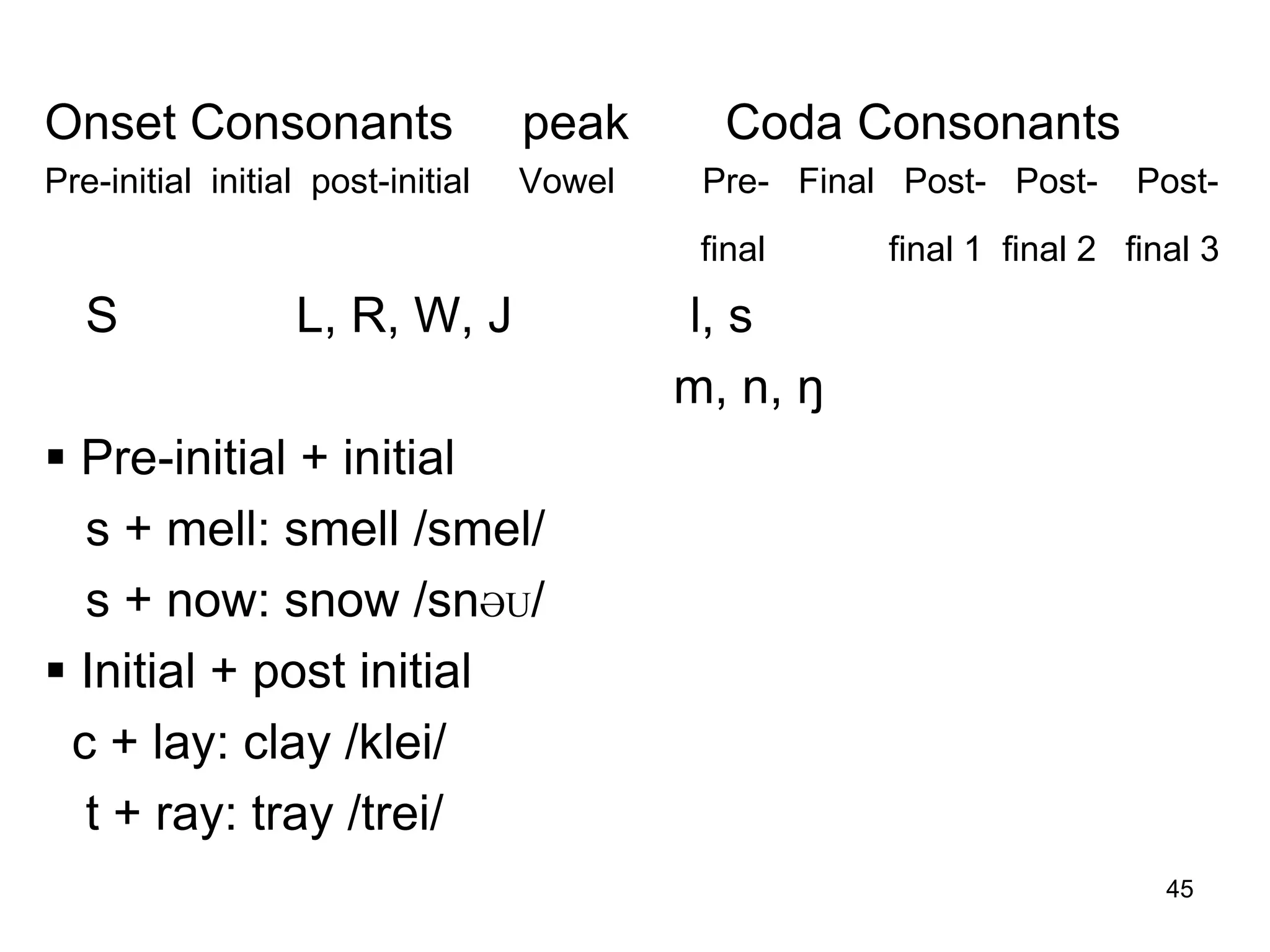


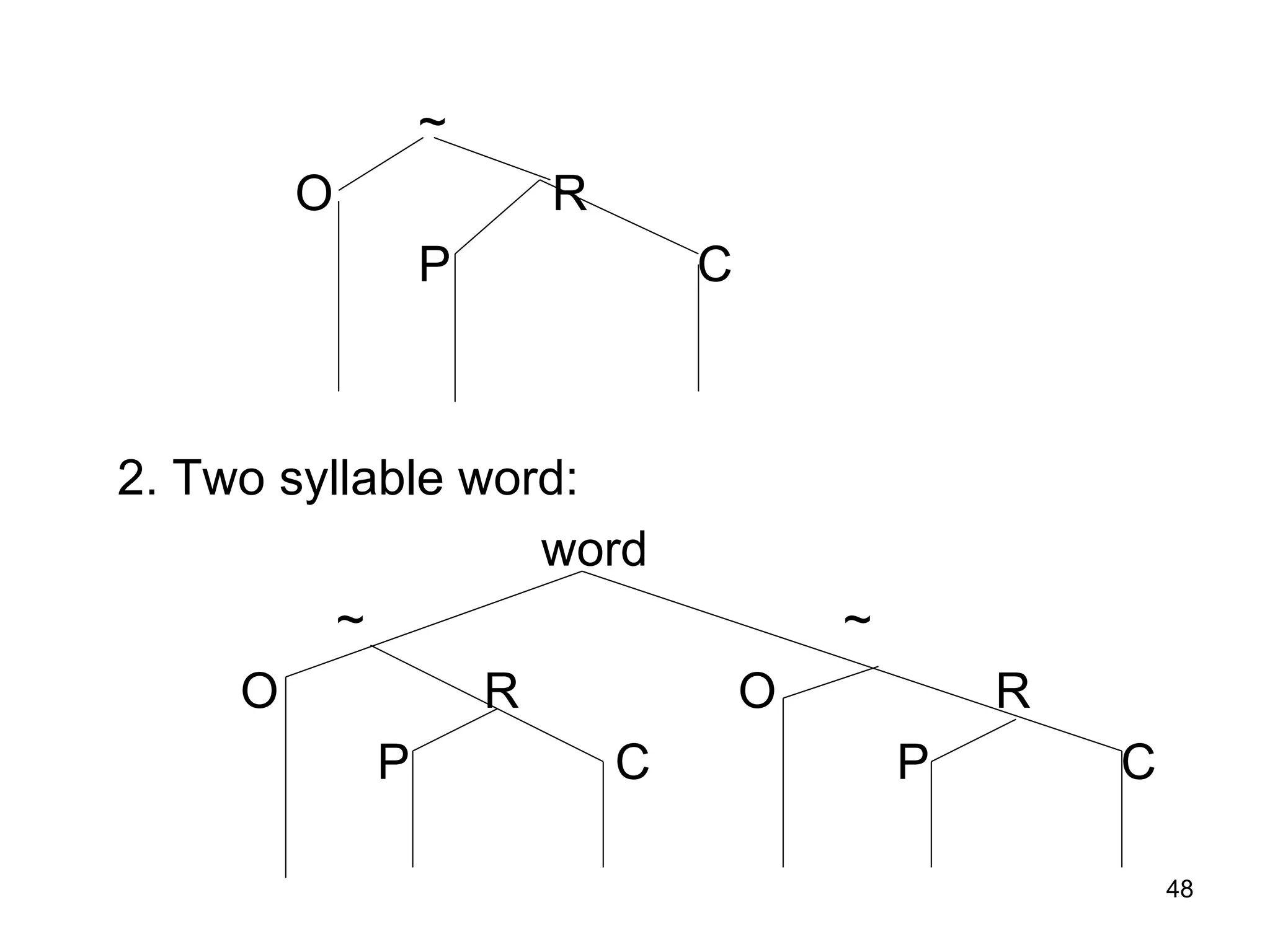
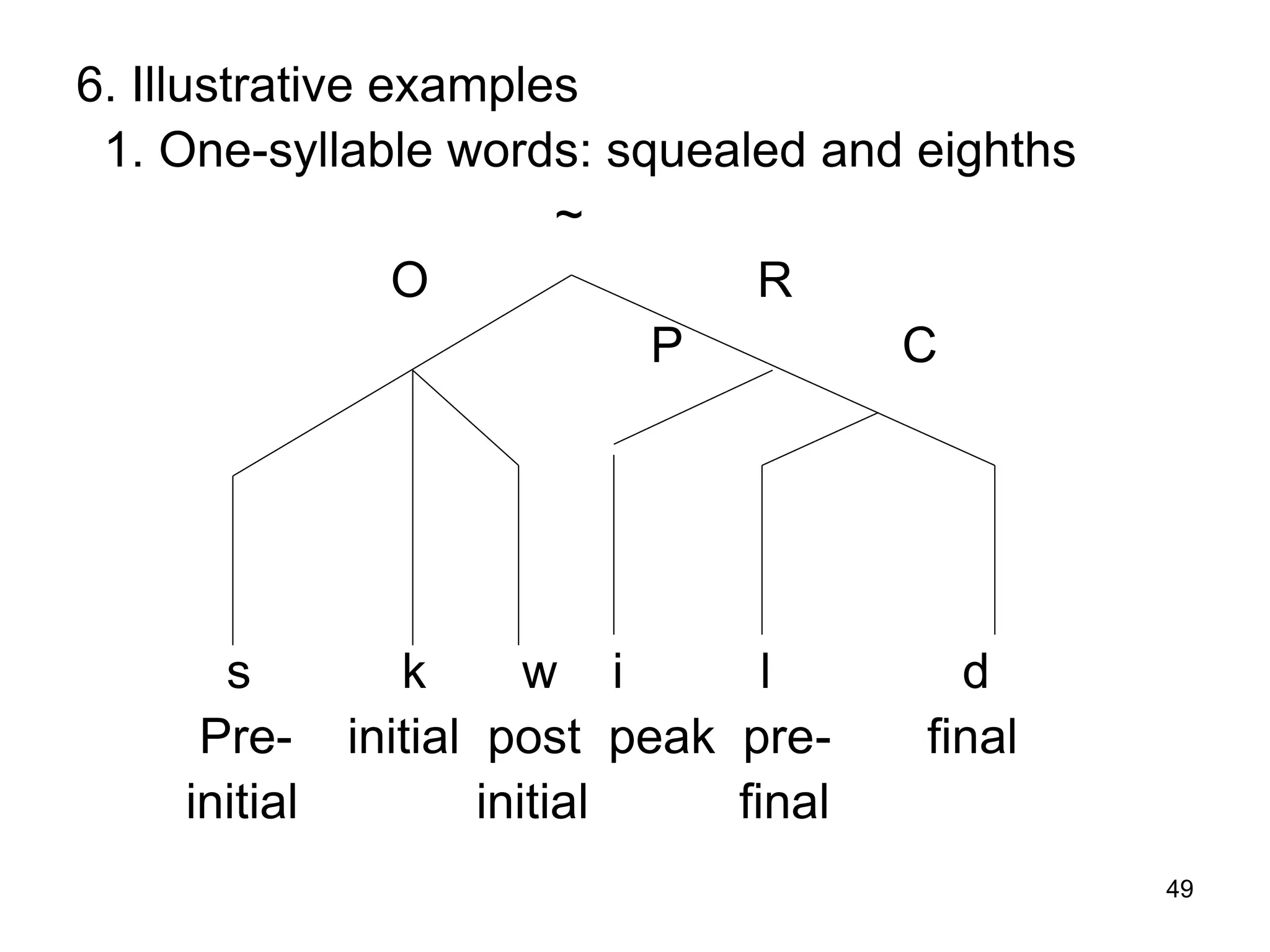
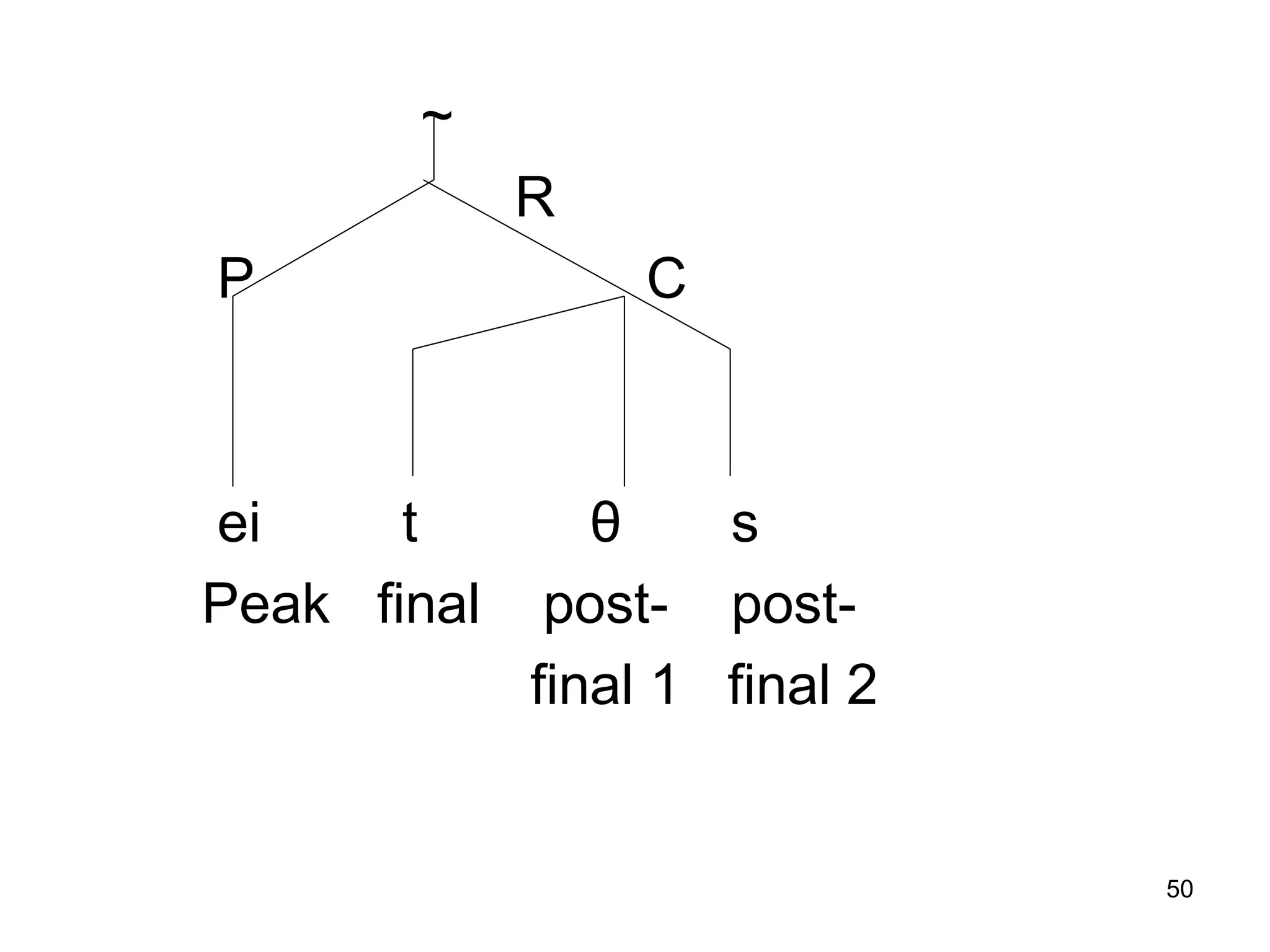


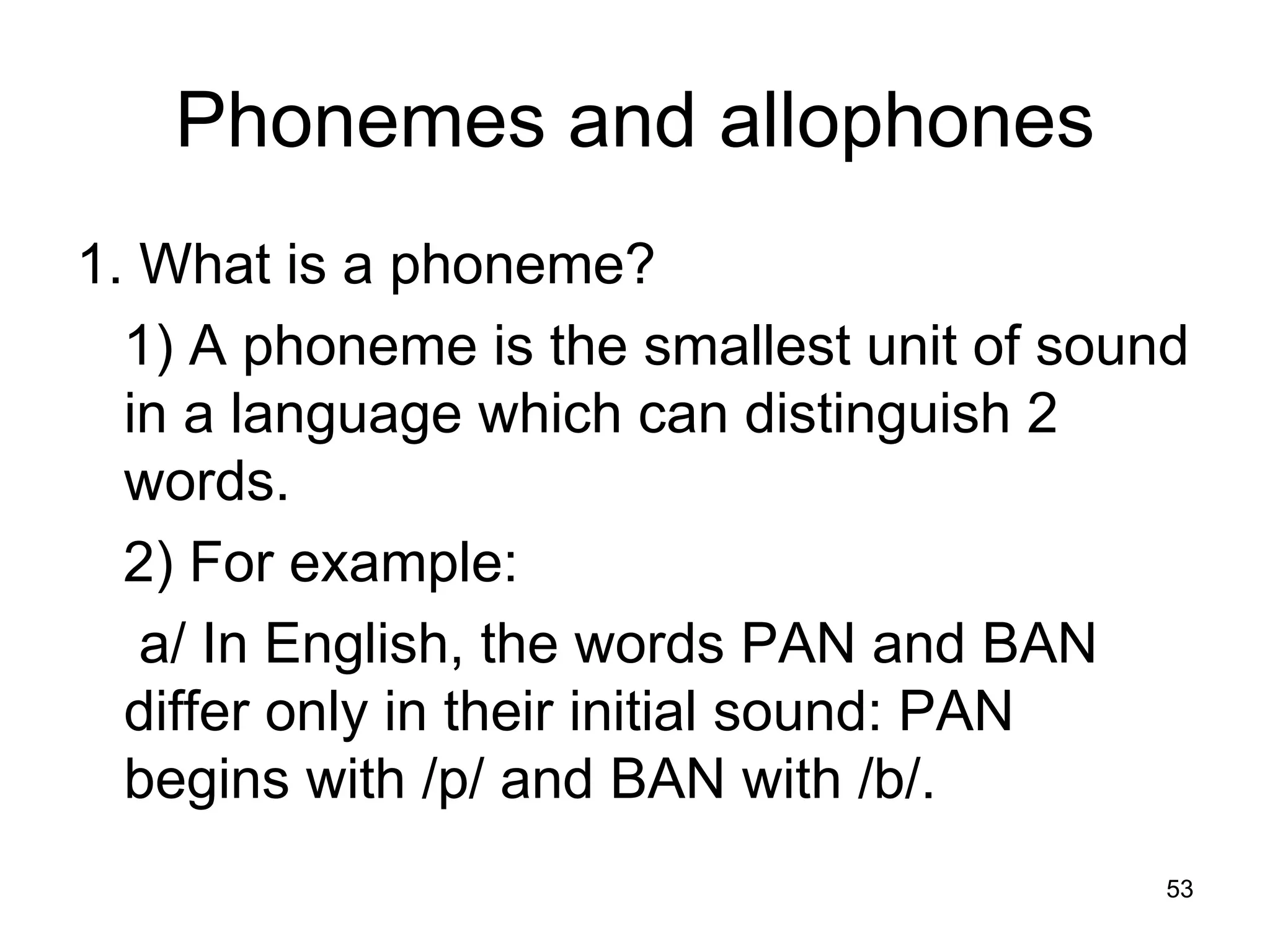

![55
2) For example: In English, when the phoneme
/p/ occurs at the beginning of words like PUT
/put/ and PEN /pen/, it is said with a little puff of
air. That is, it is aspirated. [ph].
3) But when /p/ occurs in words like SPEND
/spend/ and SPELL /spel/ it is unaspirated. [po]
4) Both the aspirated [ph] in PEN and the
unaspirated [p] in SPELL have the same
phoneme function. That is, they are both heard
and identified as [p] and not as [b]. They are
both ALLOPHONES of the PHONEME [p] > ([ph]
and [po].](https://image.slidesharecdn.com/phoneticsandphonology-220416124040/75/Phonetics-and-Phonology-ppt-55-2048.jpg)

![57
Ex: Phoneme [t] has got 2 allophones.
[th] aspirated as in TAPE.
[to] unaspirated as in LETTER.
3) Phonemes are transcribed phonemically
in slant bars / / and allophones are
transcribed phonetically in square brackets
[ ].
4) As a result of this, we have 2 kinds of
transcription: narrow transcription
(phonetic transcription) and broad
transcription (phonemic transcription).](https://image.slidesharecdn.com/phoneticsandphonology-220416124040/75/Phonetics-and-Phonology-ppt-57-2048.jpg)
![58
4. English phonemes and allophones
A. Consonants
[po] unaspirated after /s/: speak, span
1) [p] (o : unaspirated mark)
[ph] aspirated elsewhere: pen, map
(h : pronounced with aspiration)
[bo] final position: rib
2) [b] (o : pronounced without voicing, voiceless mark
[b] elsewhere: bag](https://image.slidesharecdn.com/phoneticsandphonology-220416124040/75/Phonetics-and-Phonology-ppt-58-2048.jpg)
![59
[t] after /s/: stood
3) [t] [th] aspirated, elsewhere: ten
[th
o] before /δ θ/: eighth /eitθ/
(o pronounced with tip between teeth)
[d] elsewhere: decide
4) [d] [d] before dental sound /δ θ/ breadth
[do] final position: decide](https://image.slidesharecdn.com/phoneticsandphonology-220416124040/75/Phonetics-and-Phonology-ppt-59-2048.jpg)
![60
[+kh] before front vowels: keep
(+ : voiced)
5) [k] [-kh] before back vowels: coop
(- : devoiced)
[k] after the phoneme /s/: sky
[kh] elsewhere: cake
[go] final position: bag
6) [g] [g+] before front vowels: geese
[g-] before back vowels: goose
[g] elsewhere: revolve](https://image.slidesharecdn.com/phoneticsandphonology-220416124040/75/Phonetics-and-Phonology-ppt-60-2048.jpg)
![61
7) [v] [vo] final position: revolve
[v] elsewhere: revolve
8) [δ] [δo] in initial & final position: this, booth
[δ] in medial position: breathing
9) [z] [zo] in initial & final position: zoo, dose
[z] in medial position: closet
dark [l] before consonants: milk
devoiced [lo] after /p.k/: play, clock
10) [l] [l] before dentals: health
syllable [l] after t n b d: bottle tunnel, trouble
clear [l] elsewhere or before vowels: lake](https://image.slidesharecdn.com/phoneticsandphonology-220416124040/75/Phonetics-and-Phonology-ppt-61-2048.jpg)
![62
11) [r] [ro] after voiceless consonants: pray
[r] elsewhere: right
12) [n] [n] before dentals: month
[n] elsewhere: nine
13) [m] [m] before f: nymph / nimf
[m] elsewhere: mine
B. Vowels & diphthongs
1) Diacritics show the allophones of vowel and
diphthong phonemes.
: > long vowels & diphthongs
~ > long & short vowel or diphthongs, before
nasals.](https://image.slidesharecdn.com/phoneticsandphonology-220416124040/75/Phonetics-and-Phonology-ppt-62-2048.jpg)
![63
o > long vowels or dipthongs shortened by the
following fortis consonants /p t k/.
v > short vowels or diphthongs shortened by the
following fortis consonants.
2) For examples:
[i:] elsewhere: seed [si:d]
[i] [ĩ] before nasals: seen [sĩ:n]
[io] long I before fortis consonants /p t k/:
seat [sio]
[ĭ] short i before fortis consonants /p t k/:
lip [lĭp]
3) Transcription: peat (spelling) phonemic /pit/
phonetic [phiot]](https://image.slidesharecdn.com/phoneticsandphonology-220416124040/75/Phonetics-and-Phonology-ppt-63-2048.jpg)
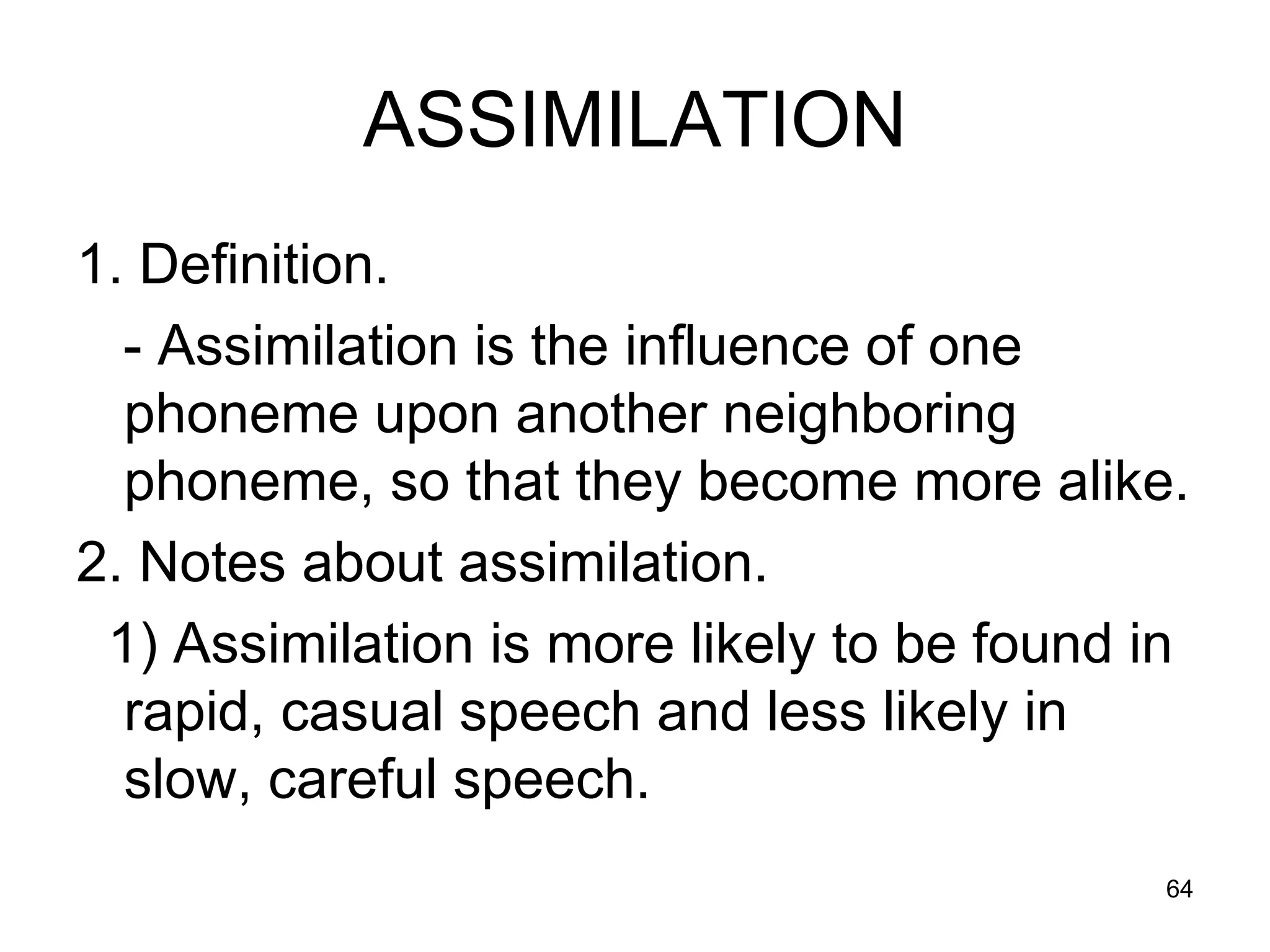

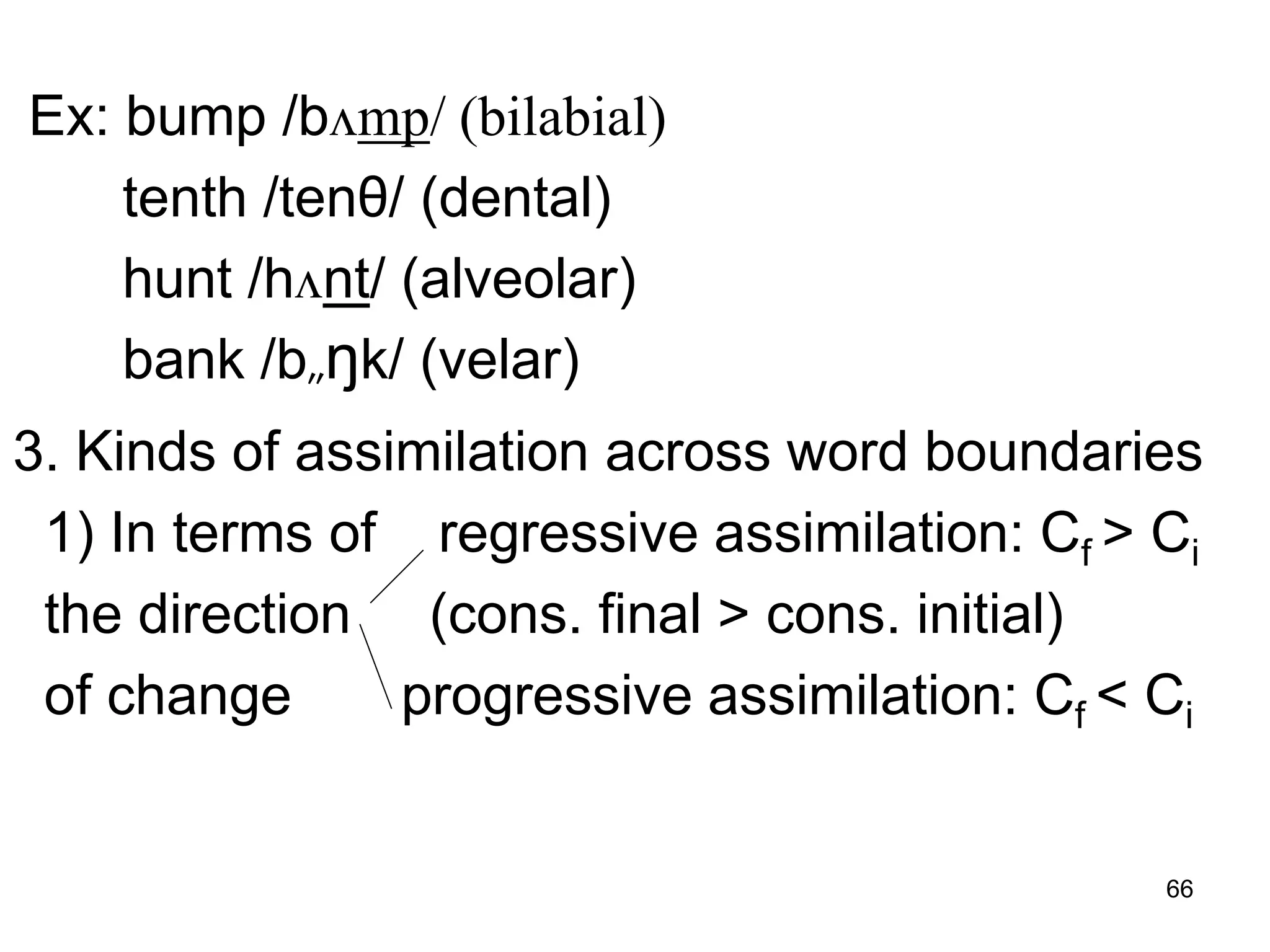
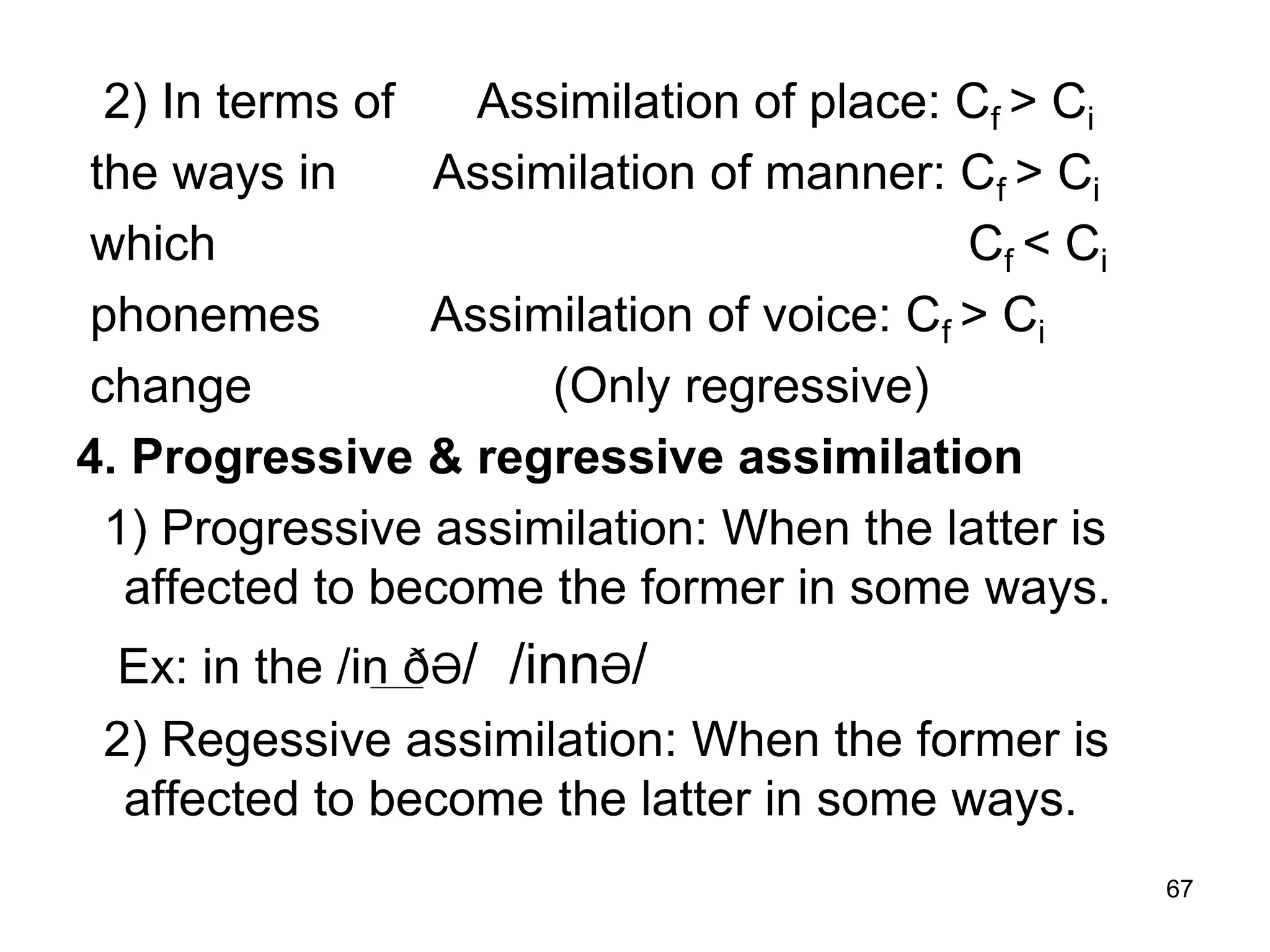
![68
Ex: one more /wʌn mɔ/ > /wʌmmɔ/
5. Three other kinds of assimilation
1) Alveolar + bilabial > bilabial (regressive ass.)
p Ex: right place /raip pleis/
t + b p [p]
m white bird /waip bɜd/
[p]
p Ex: hard path /hab paθ/
d + b b [b]
m good boy /gub bɔi/
[b]](https://image.slidesharecdn.com/phoneticsandphonology-220416124040/75/Phonetics-and-Phonology-ppt-68-2048.jpg)
![69
p Ex: gone past /gƏUm past/
n + b m [m]
m ten men /tem men/
[m]
2) Alveolar + velar > velar (regressive)
k Ex: white coat
t + k [k]
g that girl
[k]](https://image.slidesharecdn.com/phoneticsandphonology-220416124040/75/Phonetics-and-Phonology-ppt-69-2048.jpg)
![70
k Ex: bad cold
d + g [g]
g bad gate
[g]
k Ex: one cup
n + ŋ [ŋ]
g main gate
[ŋ]](https://image.slidesharecdn.com/phoneticsandphonology-220416124040/75/Phonetics-and-Phonology-ppt-70-2048.jpg)
![71
3) Alveolar + palato-alveolar/palatal > palato-
alveolar/palatal (regressive)
ʃ Ex: nice shoes
s + ʃ [ ʃ ]
j this year
[ ʃ ]
ʃ Ex: those shops
z + ʒ [ʒ]
j Where’s yours
[ʒ]](https://image.slidesharecdn.com/phoneticsandphonology-220416124040/75/Phonetics-and-Phonology-ppt-71-2048.jpg)
![72
B. Assimilation of manner of articulation
1) Plosive + fricative/nasal > fricative/nasal (regr.)
s > s Ex: that side
[s]
t + z > z that zoo
[z]
n > n that night
[n]](https://image.slidesharecdn.com/phoneticsandphonology-220416124040/75/Phonetics-and-Phonology-ppt-72-2048.jpg)
![73
s > s Ex: good song
[s]
d + z > z bad zone
[z]
n > n good night
[n]](https://image.slidesharecdn.com/phoneticsandphonology-220416124040/75/Phonetics-and-Phonology-ppt-73-2048.jpg)
![74
2) Plosive/nasal + fricative > plosive/nasal (prog.)
t t Ex: get them
[t]
d + ð d read these
[d]
n n in the
[n]](https://image.slidesharecdn.com/phoneticsandphonology-220416124040/75/Phonetics-and-Phonology-ppt-74-2048.jpg)
![75
C. Assimilation of voicing in consonants
1) Lenis + fortis > fortis (regressive; lenis
/b d g/ /p t k/ disappears)
b + p > p Ex: rob Peter
[p]
d + t > t bad tongue
[t]
g + k > k big car
[k]
2) Fortis + lenis > no assimilation because fortis
becomes unaspirated
sit down black dog
[to] [d] [ko] [d]](https://image.slidesharecdn.com/phoneticsandphonology-220416124040/75/Phonetics-and-Phonology-ppt-75-2048.jpg)



